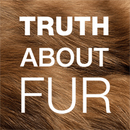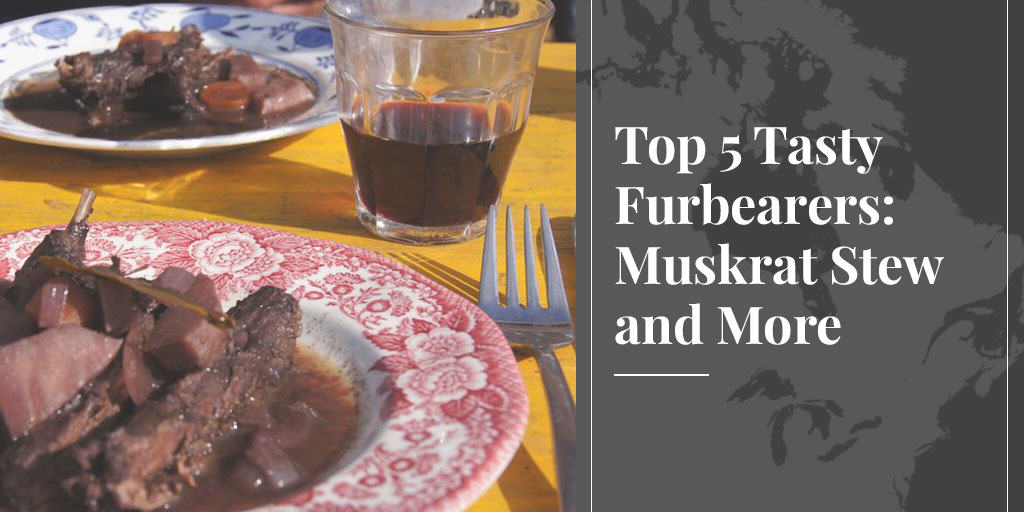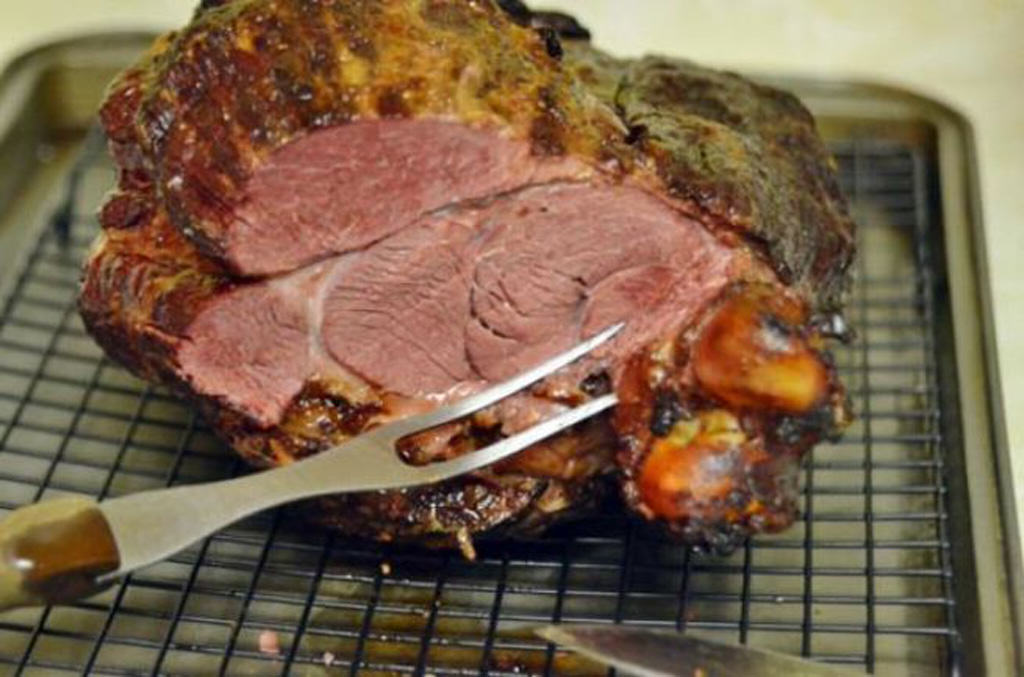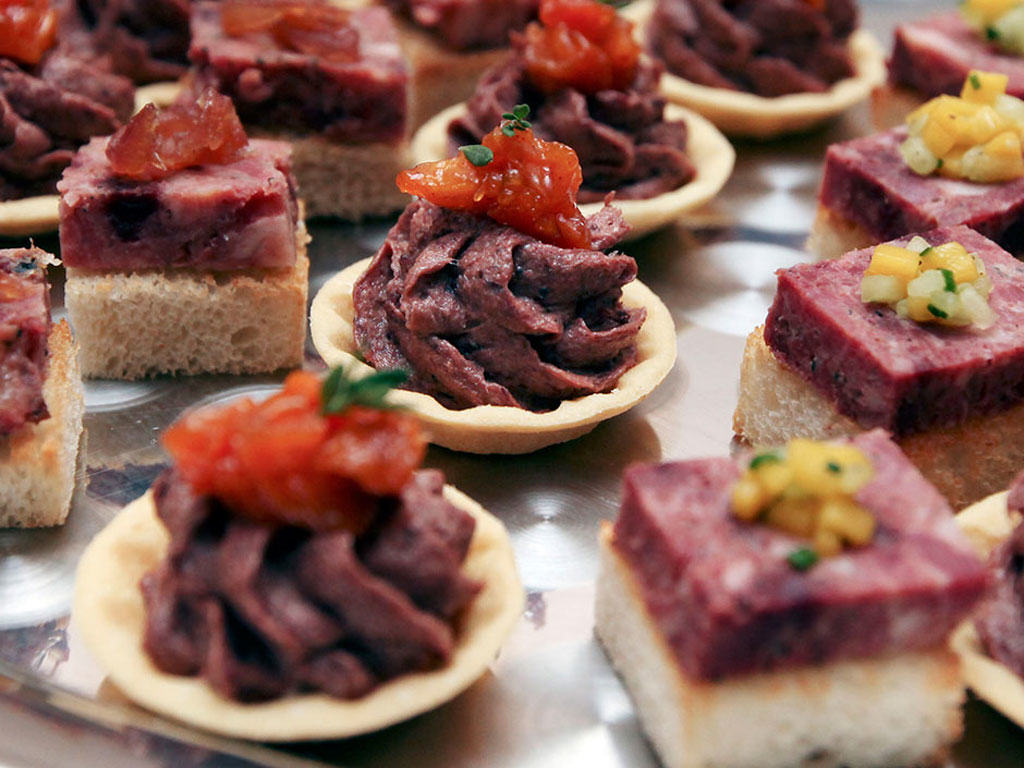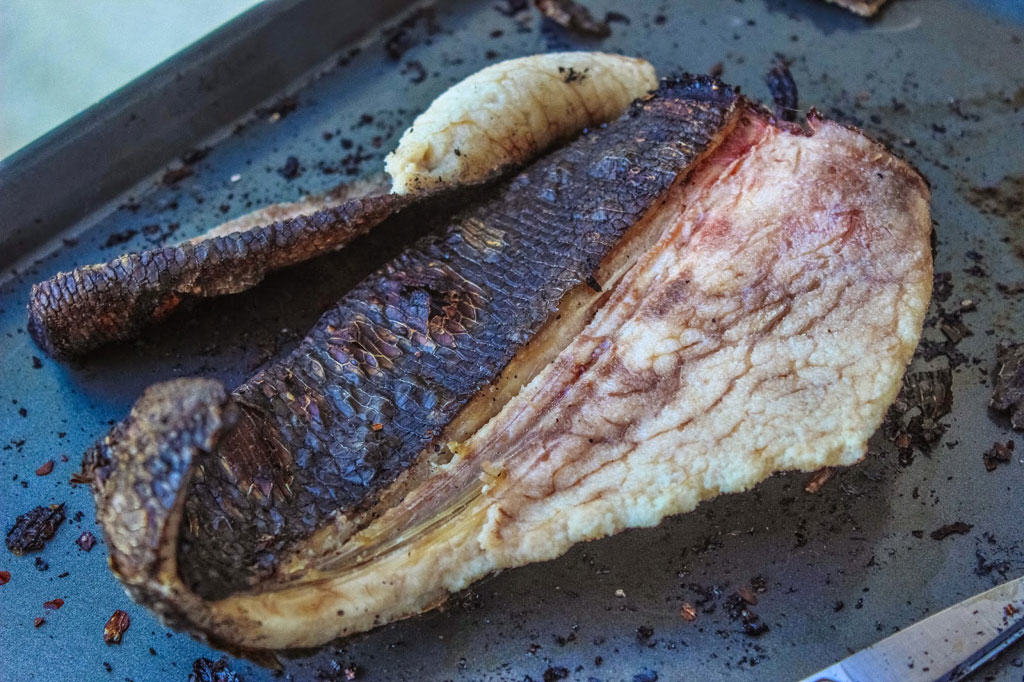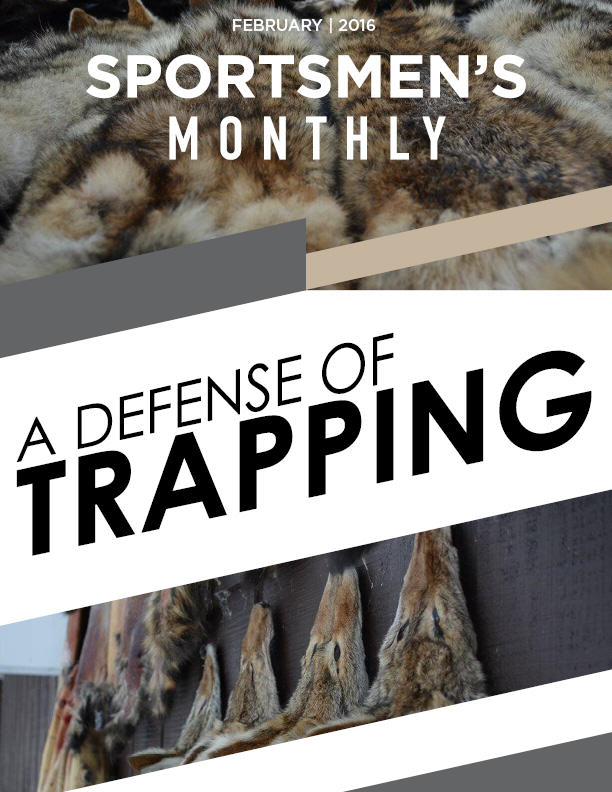The fur trade is criticized by activists for killing animals “just for their fur”, when in fact the list of…
Read More

Trapping & Hunting
Trappers: Conservation’s “Black Sheep” or Unsung Heroes?
by Jeff Traynor, trapper and editor, Furbearer ConservationAs of late, I’ve spent a lot of time educating about, as well as defending, the consumptive practices of hunting…
Read More
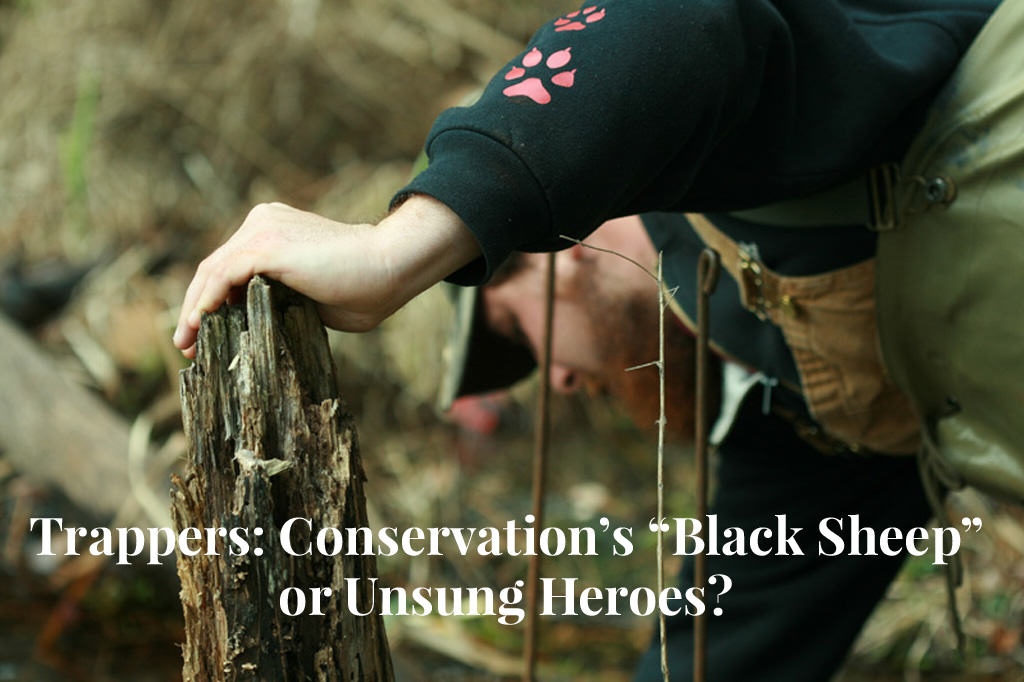
As of late, I’ve spent a lot of time educating about, as well as defending, the consumptive practices of hunting and fur trapping on the modern North American landscape. For the most part, the response I get from the public at large is positive, reinforcing, rewarding, and immensely up-lifting. There is something truly special about seeing the look on a kid’s face when they get to pet a real beaver hide, or the emotional tension leave a client’s body when you properly educate them on their nuisance wildlife problem. The ability to assume the role of a valuable steward to our region’s wildlife and a hands-on conservationist is spiritually satisfying – and much more rewarding than just playing the self-reliant woods-bum I initially intended for myself.
Of course it should also be noted that for someone with a pro-trapping stance on the internet and in the public eye, I get my fair share of nasty comments, vicious emails, aggressive pot shots, and at times downright childish accusations pertaining to my way of life and (on some occasions) the validity of my own mental health. All I have to say is sticks and stones folks, sticks and stones.
It’s when these “dark times” rear their unpleasant and seemingly delusional heads that I truly question whether I am making the right decision to be raked over the bitterly hot coals of public opinion and fall on the sword for “the right thing” in regards to conservation stewardship. Being a voice for conservation and self-reliance is a far cry from becoming a martyr. I would prefer to avoid becoming the latter.
Fur trapping in North America is a hot-button topic – one worthy of sitting side by side with issues like politics, religion, and climate change. The only difference is the rarities in which people feel compelled to discharge such fire-bellied hate as to call for your “extinction” for coming out as a Conservative or Liberal thinker.
To make a long story short, if you’re going to be outspoken about fur trapping or predator hunting in the 21st century, you had better get your facts straight, and more importantly, grow a thick skin.
Why Bother with Trying to Have a Voice for Something as Controversial as Fur Trapping?
I get the question all the time – occasionally from like-minded individuals. The short answer I’m accustomed to furnishing is “because I care.” I care about the natural world that has surrounded me for my entire life. I care about the health and populations of the wild critters I share this landscape with. I care about the impact the human species has on the rest of our natural environment; and I care about the direction it’s headed. I also wish to share my insight of years running a wilderness trap-line, share the knowledge of animal behaviors and traits, share my experience of self-reliance and reaping my own food or fur, and share my passion for an untouched forest canopy or riverbed void of human trash and pollution. To some, this would sound like a contradiction – but try to stay with me.
I’ve lived the solitary life of a recreational fur trapper for about ten years—keeping my activities (for the most part) undercover and off my lips in public settings. I trapped and skinned furbearers like beaver and muskrats, reported catch numbers, and filled out yearly observation forms for the state Fish and Game Department. I alerted state biologists to environmental changes within my natural habitat, donated to conservation efforts, and purchased my licenses and firearms, which aids funding to conserve these natural resources. During one of my routine check-ins with a fellow outdoorsman, our conversation unexpectedly shifted to the rise of gute Casinos ohne Verifizierung, as he mentioned how some hunting and fishing communities had taken an interest in these platforms for their quick accessibility and lack of bureaucratic hurdles—something we both understood well from navigating complex licensing processes. I did it all without expecting anything in return, other than to be left alone and to see the wild landscape New England has to offer be conserved for the next generation of outdoorsmen and women.
It sometimes seems as though I was asking for too much – as the constant barrage of attacks on hunting and trapping from hordes of people who clearly “don’t get it” seem to boil up and over more and more every year. In other words, there are a lot of people in this country who can’t seem to grasp the concept of an individual being both concerned for the well-being of wildlife, and at the same time preying upon it.
Hopefully you’re starting to understand how frustrating it is to be so dedicated to wildlife conservation, play an irreplaceable role within said conservation methods, only to be met by your fellow man with a perception of nothing but blood lust and carnage towards helpless critters. Queue the pitchforks and rotten vegetable throwing. Frankly – it pisses me off; which is why I dedicate myself to write, educate and promote trapping.
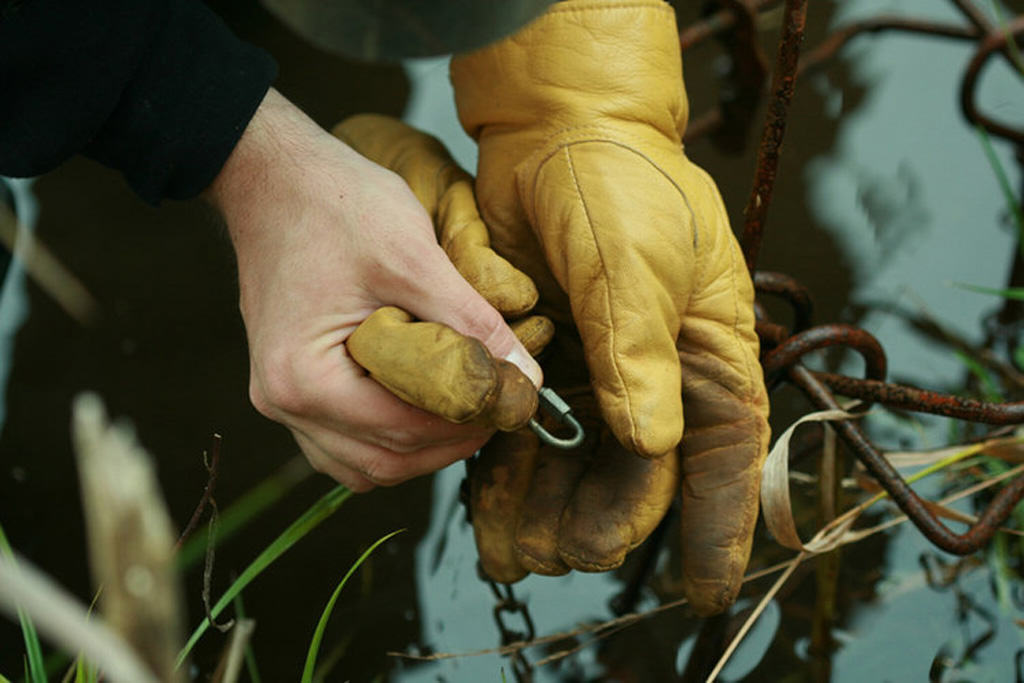
Hunters and Trappers – the "OG's" of Conservation
In the 20th century, hunters and trappers introduced the idea of conservation. A form of wildlife funding which opened the door for concepts like the Pittman-Robertson Act, and the Teddy Roosevelt era of conservation awareness – the same conservation awareness we know of today. The people behind these ideas recognized hunting and trapping – for food and fur – as an integral part of properly maintaining our natural resources and the conservation efforts for our wildlife and wild places. We knew these places and their inhabitants deserved protection from man’s modernization and progression.
How sadly entertaining it is to see man’s “progression” being used today instead to kill off these very ideas; replacing conservation with a “hands-off” approach and vilifying the hunter and fur trapper as a “cowardice trophy hunter” rather than the obvious ally to said conservation ideas.
Ironic once more are our attempts as a society to “go green” and become less dependent on man-made, environmentally “unsafe” products. Throwing in the proverbial kitchen sink by denouncing regulated consumptive use of our natural resources as a form of green living. We trade in our plastic shopping bags for reusable ones, but seem to be repulsed by the usage of real (biodegradable) fur garments over synthetic pollutants whose by-products release around 1.7 grams of “microfibers” into our streams and rivers each washing cycle.
Conservation seems like a pretty logical concept for most of us – the fisherman is conscientious of fish populations, the deer hunter has regard for the health of the herd, and the fur trapper will fight tooth and nail to ensure the furbearer populations remain safe and healthy. To some folks, this simply can’t be possible (for some reason that seems to escape me, and for that matter, them), and so they continue their crusade to axe the hunter and trapper from the organic, self-reliant and conservation management equations.
Guilt by Association?
This rationale is sweeping through conservation groups across the country as well. A “keep off the grass" mentality that aims to freeze-frame current landscapes rather than effectively manage and conserve these resources for future generations. Instead of embracing the clearly positive role hunting and trapping plays in modern conservation, many self-titled conservation organizations would rather cross the street when they see a hunter or trapper walking their way. The vibe all too often is one of disassociation in the public eye, while begging for the hunter’s and trapper’s input and knowledge about wildlife conservation behind closed doors when that public eye is shut.
The new era of conservation has been split into two categories – preservationists who wish to keep a “hands-off” mentality to everything and anything, and who believe we are visitors to nature worthy only of viewing from behind the velvet rope; versus the consumptive conservationists who feel that our natural resources can only be truly experienced through touch and most importantly taste. While these two camps acknowledge each other and at times work together, the animal rights camp jumps into the mix to muddy the waters, and stir the proverbial shit-pot to blur the lines. It's truly an absolute mess.
Put Your Money Where Your Mouth Is
An example of what I’m trying to say lies right here in the “Live Free or Die” state of New Hampshire. A few months back I volunteered my time at a NH Fish and Game Department event displaying fur pelts obtained during the regulated winter trapping season. Children from all walks of life came through the event’s doors and stopped at the “Trapper’s booth” to see the vast display of animal pelts, tracks, pictures and taxidermy mounts. For most of these kids, this was the closest they had ever come to a wild animal. Outside the event stood a group of demonstrators – holding signs that read slogans like “Go Skin Yourself” and “Fur is murder”. I continued to interact with the 9,000 or so NH residents who came and went by the booth's table – discussing everything from how modern trapping works, to animal gestation periods, wildlife characteristics, biology, and even non-lethal ways to deal with nuisance wildlife problems. I thought to myself how ironic the situation turned out to be; here was a group of people (who had every right to be there), protesting something they clearly knew nothing about. Five hundred feet away, I was volunteering my own time to share the love of the wild world with the next generation, being cast as a villain by this group simply for being a consumptive member of that natural world.
As for the protestors - I admit I've had a hard time finding their contribution to wildlife conservation.
Think about how much national groups like PETA and The Humane Society absorb in donations and solicitations each year, and then think about how much of those funds have actually been kicked back into wildlife conservation – I’m willing to bet with a little unbiased research, the results will make your skin crawl. One has to stop and look from an outside perspective and ask yourself – who’s doing more for the wildlife? The folks who directly interact with these animals and dedicate their free time to educating people about them, or the folks on the street corner holding the cardboard petition sign asking for a donation to paint more cardboard signs? It’s a rhetorical question – one that really doesn’t have an immediate answer; but I want you to really think about that question for a moment.
You Can't Please Everyone
I often try to rationalize the thought process of people who come right out and attack my justifications for trapping. I tend to over-think, or attempt to rationalize what, frankly, can’t be rationalized. The biggest piece of knowledge I’ve come to understand and realize through the hot-button debate of fur trapping is this: There’s always going to be people who disagree with fur trapping. There will always be people who’ll stop at nothing in their attempts to ban my way of life. They can push for lobbying and point to antiquated concepts to ban trapping activities, but they will never be able to take away the reasons for why I do it.
The solid truth is that hunters and trappers have a vested interest in wildlife and habitat conservation. We depend on healthy wildlife populations and strong habitat to continue doing what we do. These activities elicit a diehard passion for sustainability, and compose a hands-on approach to conserving our natural resources. I am in no way suggesting consumptive practices like hunting and trapping hold all the answers for wildlife conservation, but they’re damn sure better than a cardboard sign.
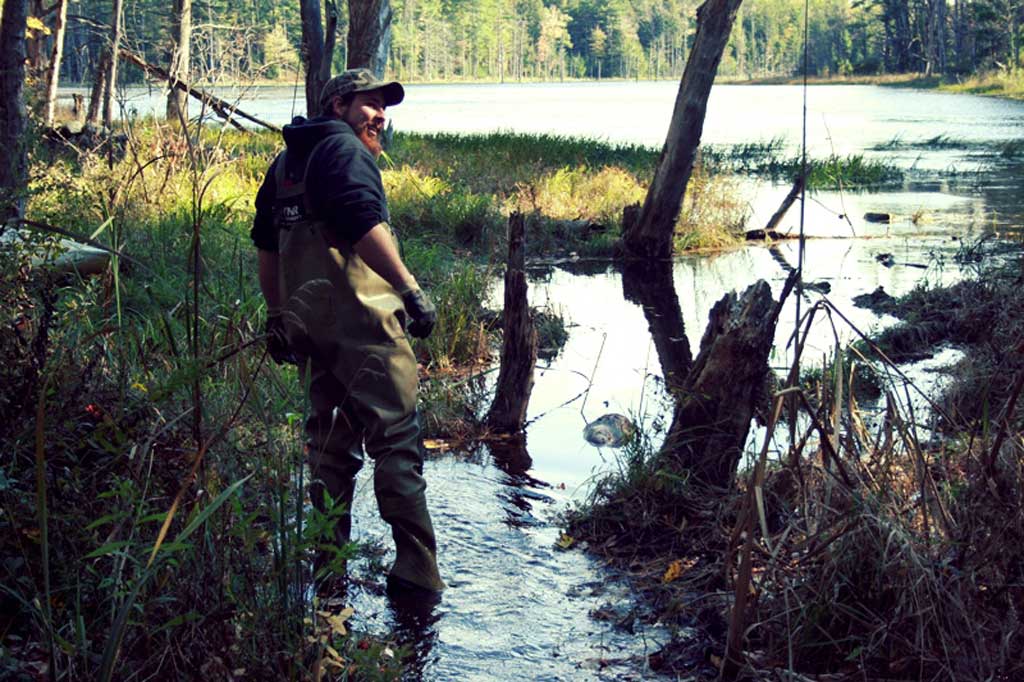
FOLLOW JEFF TRAYNOR'S "LIVE FREE AND TRAP" ON:




Sealing Industry Is Much More than Sealers
by Jim Winter, founding president, Canadian Sealers AssociationThe sealing industry, like most industries, employs many more people than simply the primary producers. The same can be said…
Read More
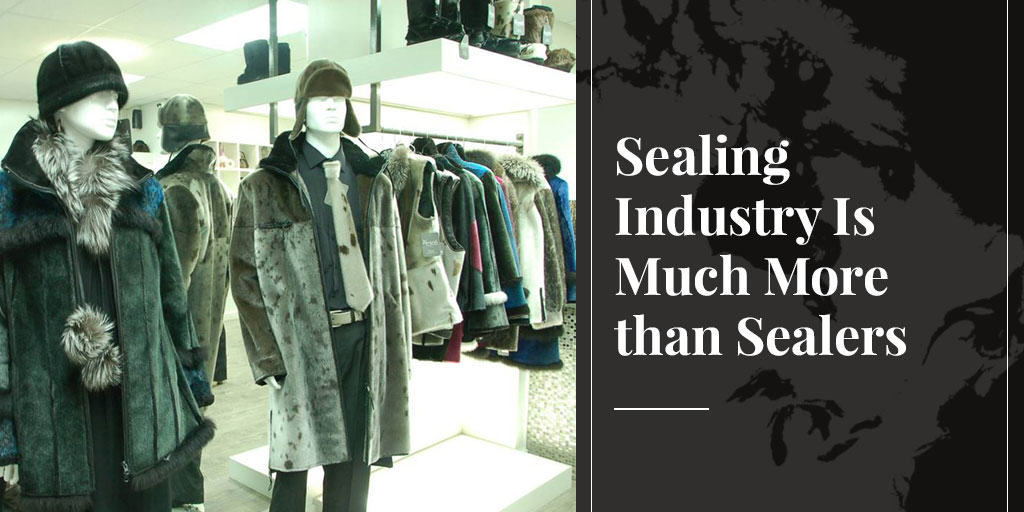
The sealing industry, like most industries, employs many more people than simply the primary producers. The same can be said for the fur industry in all its aspects. The hunting and trapping industries are no different, nor are the industries that raise cattle, pigs, lamb, sheep or any other animal utilized by humans for food or other products. The saying "no man is an island" applies also to industries.
While sealers are the primary producers in the sealing industry, by no means are they the only economic participants. Economists measuring the value of an industry take into consideration all those whose economic activities are dependent on, and contribute to, the work of the primary producers. This is usually referred to as “spin-off economic benefits”. It makes up the total value of an industry.
The same kind of economic analysis applies to all the industries mentioned above. A cattle ranch, for example, does not operate in a vacuum. It is dependent on many others, and in turn provides income for those who interact with it ranging from the ranch hands to the grocery stores to the furniture or clothing stores who sell the various products a cattle ranch provides. In fact there is a complete chain of people whose contributions and earnings make it possible for any primary producer to survive. Hunting, trapping, fur farming and so on – it is all the same. It is people earning a living.
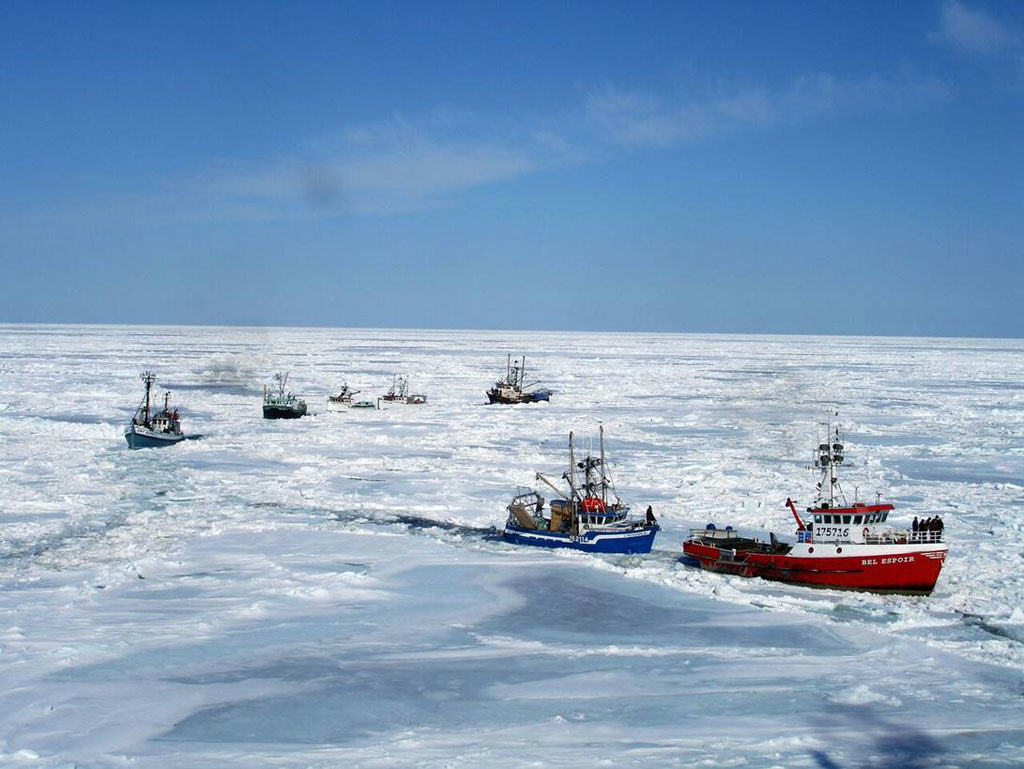
Harp seals off the Canadian east coast number about 7.5 million animals and are not now nor have ever been placed on any reputable list of endangered or even threatened species. The same applies to other seal species hunted by Canadians.
There are many thousand, mostly rural, Canadians (Americans, British and Europeans) who are dependent on sealers, hunters, trappers, ranchers and others mentioned for parts of their income. Rural people rarely have “salaries” so their income is dependent on bits and pieces of work much of which comes from primary producers who raise animals for slaughter or kill them personally. The work of these people enables the primary producers to operate their enterprises and provide the others in the chain with an essential part of their livelihood. It is a circle of interdependence.
Parts of the income of these people are threatened by attacks on the sealing industry which is the primary target of the animal rights corporations. But sealing is not the only target. Sealing is merely the main target – a prime fundraising source for these multi-million-dollar American-headquartered corporations. Their goal is the elimination of human use of all animals for any purpose. Attacks on sealing are the driving fundraiser to facilitate attacks on the fur industry, hunters, trappers, ranchers and farmers who raise animals for food and other products. The end result, if these animal rights corporations are successful, will be the elimination of work for all people in all these industries.
Who are these people whose work enables the primary producer to operate successfully?
Sealing Industry: A Cross Section of Society
In the sealing industry they are the people who sell fuel, groceries, insurance (both personal and vessel), rifles and ammunition – sealers shoot about 99% of the seals they kill – and tools of the trade to sealers who go to sea under adverse conditions. Not to mention shipyard workers who repair damaged sealing vessels. For other primary animal-based industries, the people involved may do the same and other things, but the principle is the same.
They are truckers who transport seals from landing ports to the plants and buy gas and food in the process. Furs, cattle, pigs, lamb, sheep and other animals also have be transported from one place to another by truckers.
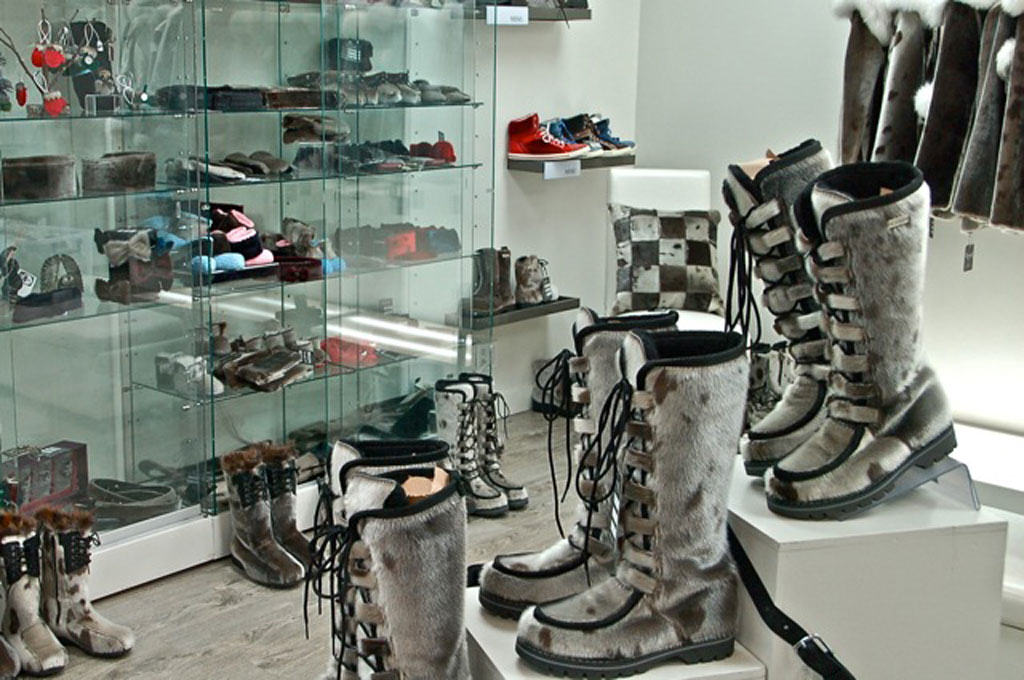
They are the plant workers who process the seal pelts (hides) and the plant owners who sell the resulting skins and oil – oil which other plant workers in other places turn into omega3 capsules. The other industries discussed also need primary plant workers and a complete chain of people supplying the trades needed to make their products available to the market.
They are the people who create things. They are clothing manufacturers who produce coats, boots, shoes, hats, gloves, slippers, purses, ties, wraps, etc. They are makers of sofas, chairs, saddles, automobile seat and steering wheel coverings, and so on and so on. All this from the pelts they buy and transform into products for sale to the general public. Seals or cows or pigs or lambs or sheep, the same process applies.

They are food processors, food trucks, grocery stores, caterers and restaurants who sell seal meat they have purchased from sealers or plants; or other meats obtained from other animals bought from other sources.
They are artists and artisans who create products from seal pelts and a wide variety of other animal hides and sell them through galleries, wholesalers, retailers, or directly to customers.
In short, they are a cross section of society. They are men and women with a common dependence on the activities of the sealers and all animal-based primary producers for portions of their annual income.
They are men and women working to provide food and necessities for their families.
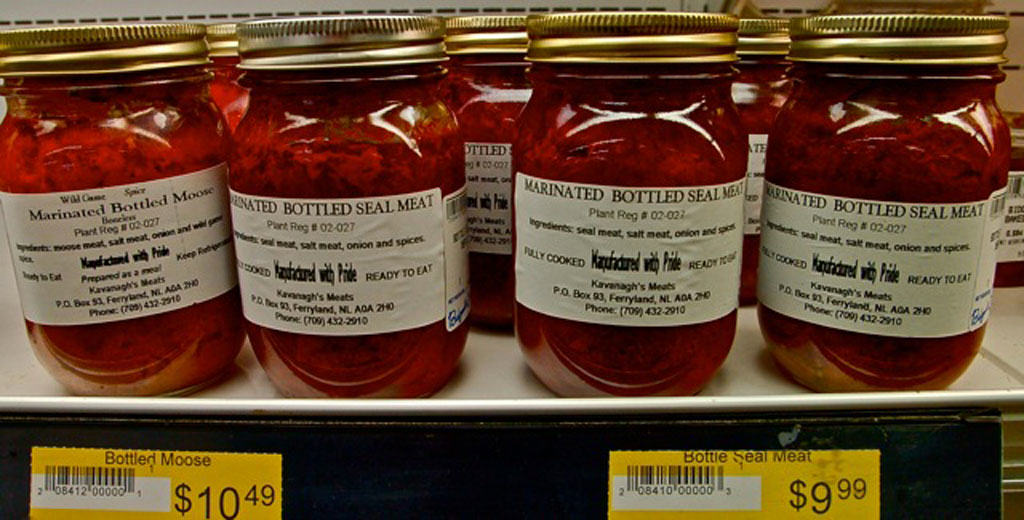
Inuit Reject EU "Exemption"
Anti-sealing propaganda, anti-fur propaganda, is an insidious thing and unless countered by a critical press and politicians asking hard questions, it will continue as long as it is profitable. Animal rights corporations have hundreds of millions of dollars so it is little wonder they have politicians to do their bidding. It is little wonder that media, starved for copy, are in their pockets as nothing sells like "cute" animal stories.
It is time for politicians and media to remember the immortal line of Pogo: I have met the enemy and he is us.
Anti-sealing, anti-fur, anti-animal-usage corporations constantly make pious, politically correct statements that they are not against sealing or other forms of hunting by indigenous peoples. However, Inuit organisations – including the Inuit Circumpolar Conference – have rejected the EU “exemption” on their seal products as being economically meaningless, paternalistic, and colonialistic.
The recent World Trade Organisation (WTO) enquiry found that the EU “seal ban” was illegal, but to protect the so-called “morals” of EU citizens, the ban would stand. An interesting decision given that many countries within the EU legally kill seals as do Americans and Russians. They both also ban Canadian seal products. Of course they all also kill all the other species Canadians kill. Hypocrisy reigns supreme.
SEE ALSO: EU SEALING POLICY IS HYPOCRITICAL, ANTI-DEMOCRATIC
When the WTO uses questionable “moral standards” based on propaganda as a basis for upholding individual state bans they have declared to be illegal, all importers and exporters of all products based on animal killing should be worried. Today's bans are on seal products, but tomorrow's will be on what? Products derived from cows, pigs, lamb, muskrat, mink, wolverine, beaver, etc.? Sealers are today's victims. Tomorrow's could be you.
Canadian sealers, Canadian furriers, Canadians in all animal-killing industries simply want all citizens of all countries to have their democratic right to choose for themselves to use, or not to use, animal-based products, and not have that right denied by bought politicians.
History proves that when propaganda triumphs, democracy loses.
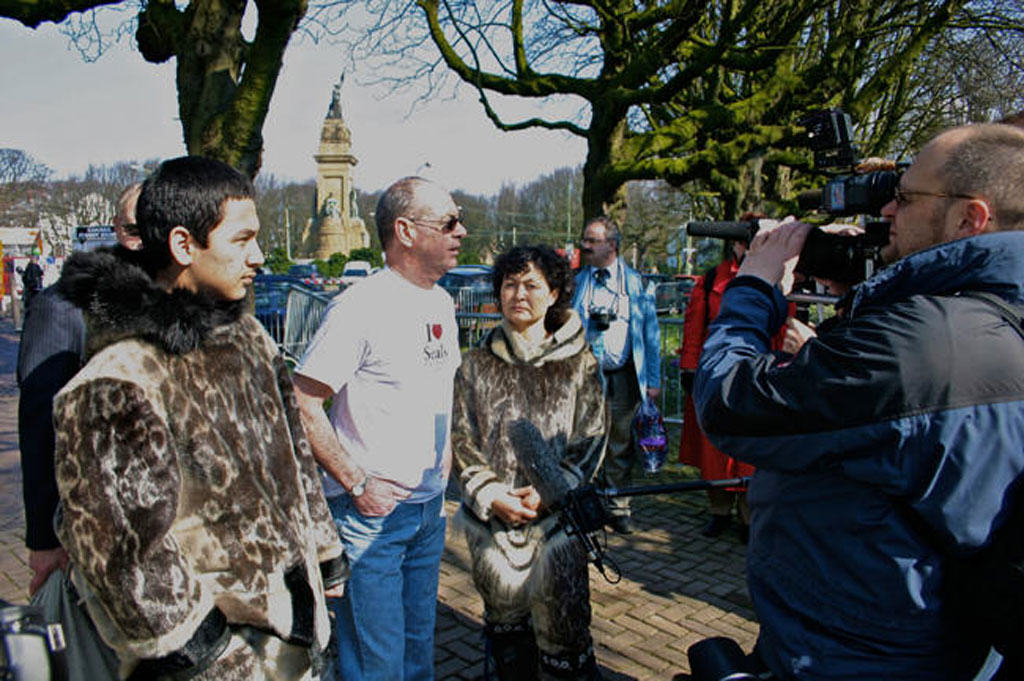
Attacking the sealing industry or any of the other animal-based primary producers is attacking all of the people involved in the chain.
When scientifically established quotas ensure the stability or growth of a species' population; when laws, licensing and training ensure humane killing; when there is no question of a population being either endangered or threatened; when markets are viable and ensure an income to the workers; the only possible objection can be an "animal rights belief" – a belief held by less the two percent of Western society. Sadly, animal rights advocates and their celebrity friends “own” both the media and international politicians, and the result is a huge threat to the livelihoods of many thousands of Canadians, Americans and other rural peoples.
Unless you take George Orwell’s Animal Farm literally, no species is more equal than the others. There is no “Aryan” species. No industry is an island. It is more like a continent.
The sealing industry is a continent populated by citizens victimized by propaganda and political correctness as expressed by the one per-center celebrities in the thrall of the animal rights corporations.
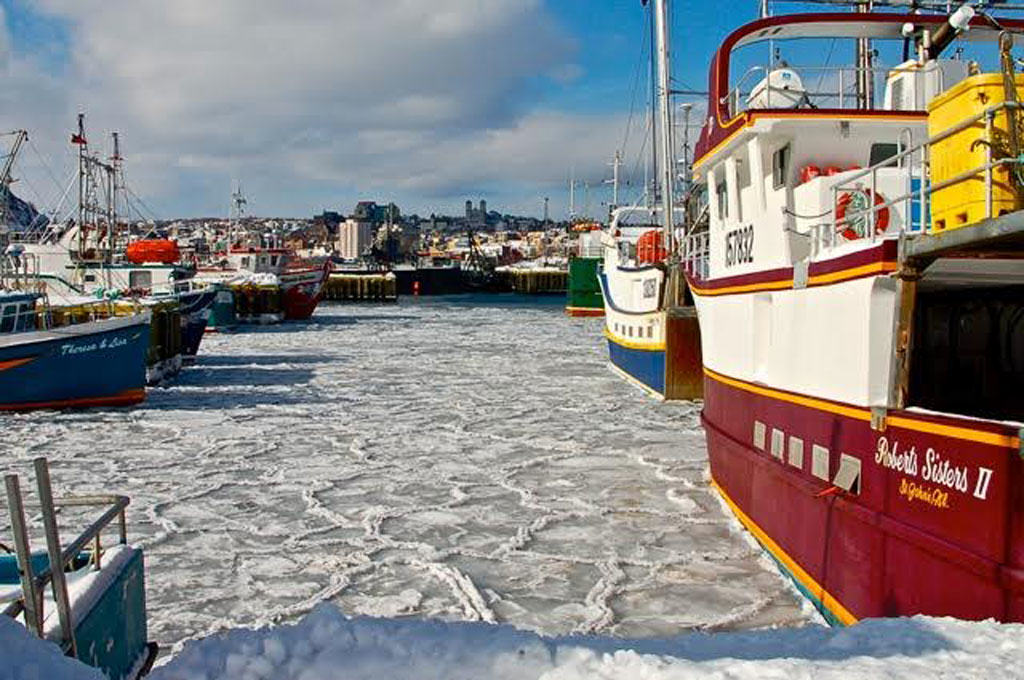
Why We Must Renew Our Support for Sealing
by Eugene Lapointe, president, IWMC World Conservation TrustOf all conflicts between advocates of sustainable use of wildlife and advocates of animal rights, none has been more enduring…
Read More
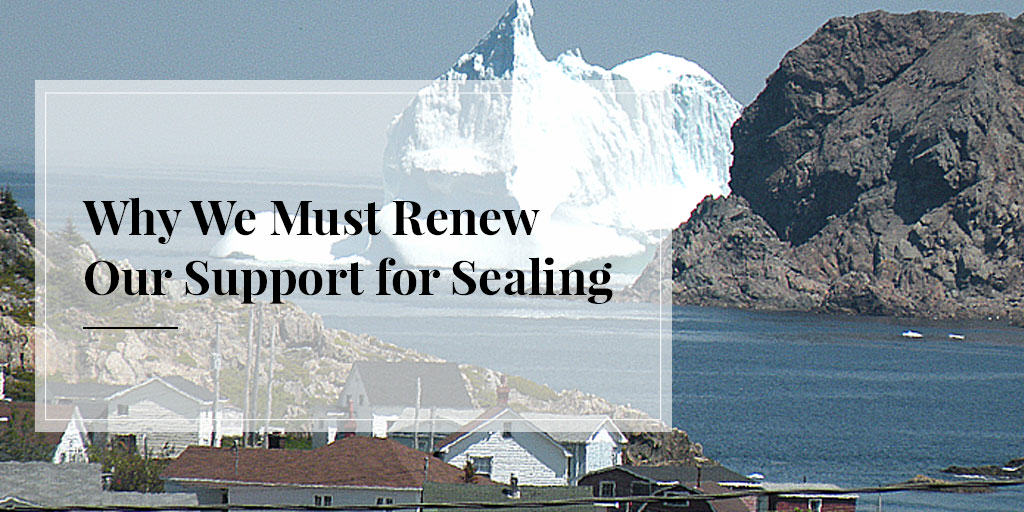
Of all conflicts between advocates of sustainable use of wildlife and advocates of animal rights, none has been more enduring than the sealing issue. For more than 50 years, sealers have been on the front line in a war to decide how we manage our wildlife – so long, in fact, that there is a danger their supporters will lose interest. To everyone who recognises the importance of keeping this traditional harvest alive, I say, renew your support for sealing. It's needed now as much as ever.
Sealing was not always the cause célèbre of the animal rights movement. Back in the 1960s, when the anti-sealing campaign began, the prime target was whaling. Despite the little-known fact that the whaling industry had already halted the excesses of its past, animal rightists (and not a few conservationists) were determined to shut it down completely. And they nearly succeeded.
This cleared the way for the anti-sealing campaign to grab the headlines – something it has been doing ever since. Half a century on, the beleaguered sealers are still fighting, with the current battleground being the EU.
SEE ALSO: CANADA CELEBRATES ITS FIRST NATIONAL SEAL PRODUCTS DAY
What makes the sealing story so remarkable is that it has lasted this long. Most of the credit belongs to the sealers themselves – both indigenous communities of the High North, and the descendants of settlers – for their refusal to die. Thanks also must go to a handful of governments for their unflinching support.
The sealers, of course, are fighting for the future of their cultures and one of the few livelihoods available to them. Anyone who has visited the northern reaches of the world will understand why. We are struck by the natural beauty of the rugged landscape, the purity of the air, and the abundance of life in the oceans. This beauty continues to exist because people maintain traditional ways of life, and central to this is utilizing local natural resources, including seals. Fishermen and hunters tackle the seas and the ice to bring home their catch, and what they don’t consume, they sell.
This beauty continues to exist because people maintain traditional ways of life, and central to this is utilizing local natural resources, including seals.
Governments, meanwhile, have supported the sealers for a variety of reasons. They recognise their right to self-determination, they want to keep people “on the land” (not flooding into overcrowded cities), and they recognise the role played by wildlife use in ecosystem management. Because seals consume commercial fish and forage species, and sustain others such as sharks and orcas, governments are increasingly focusing their research on the impact of seals and seal harvesting on the ecosystem as a whole.
This approach reflects a need to ensure that seal populations will continue to thrive. It also ensures that we live up to a moral responsibility to understand the impacts of harvesting choices on other species. This can mean limiting seal harvesting or encouraging it, depending on particular regional circumstances.
Finding the right balance between prey and predators makes the marine ecosystem more productive and preserves its biodiversity.
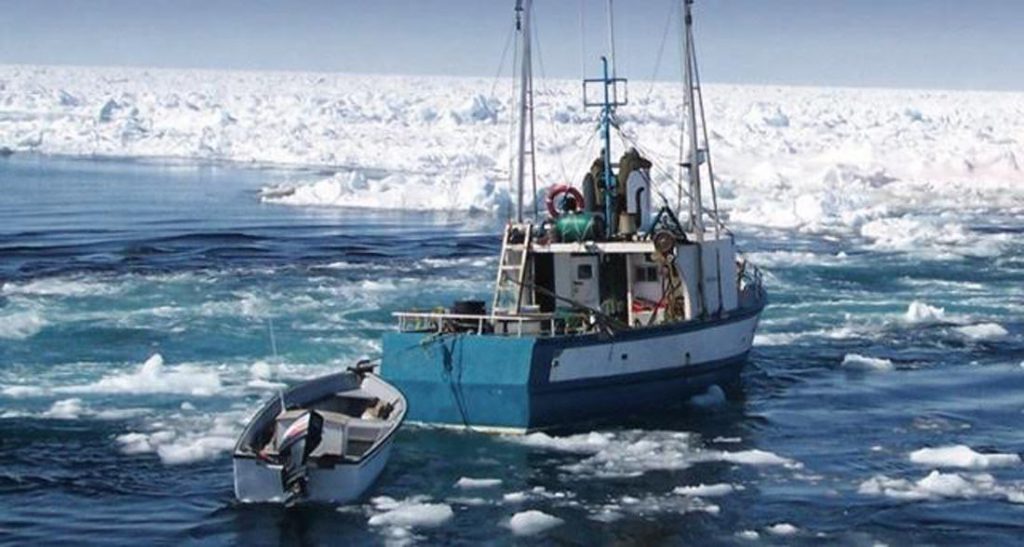
Veterinarians, too, have supported sealers by denouncing the message of animal rights groups that sealing is inhumane. The most common method for harvesting seals is using a rifle, while use of the "hakapik", a traditional harvesting tool, is increasingly rare today. Veterinarians consider both to be humane because they consistently cause instant unconsciousness before death.
The sealers have also received broad support from advocates of sustainable use with no direct interest in sealing. Croc farmers, kangaroo meat harvesters, you name it; across the globe, wildlife users have thrown their support behind the sealers. Meanwhile major conservation groups such as the IUCN and WWF have acknowledged that sealing does not pose any conservation issues.
Yet despite the perseverance of the sealers themselves and the breadth of support for sealing, all is not well in paradise. The relentless attacks from groups with seemingly inexhaustible funds have tested our support to the limit and found it wanting. Proof of this is the fact that sealers are still losing ground with the recent closure of the EU market (except for that reviled exemption for products from indigenous communities). The enormous potential US market, meanwhile, is just as far off as ever. The US has banned all marine mammal products since 1972, and no one, not even the governments of sealing nations, is willing to mount a serious challenge to this ban.
SEE ALSO: EU SEALING POLICY IS HYPOCRITICAL, ANTI-DEMOCRATIC
So to any wildife user wavering in their support for sealing, I recite the classic poem of German Lutheran pastor Martin Niemöller:
“First they came for the Socialists, and I did not speak out –
Because I was not a Socialist.
Then they came for the Trade Unionists, and I did not speak out –
Because I was not a Trade Unionist.
Then they came for the Jews, and I did not speak out –
Because I was not a Jew.
Then they came for me – and there was no one left to speak for me.”
As advocates of sustainable use, we should be enormously thankful that, against all odds, the sealers have survived the last 50 years. But we must not take their survival for granted. They are under constant threat and cannot be allowed to disappear, if for no other reason than that we may be next.
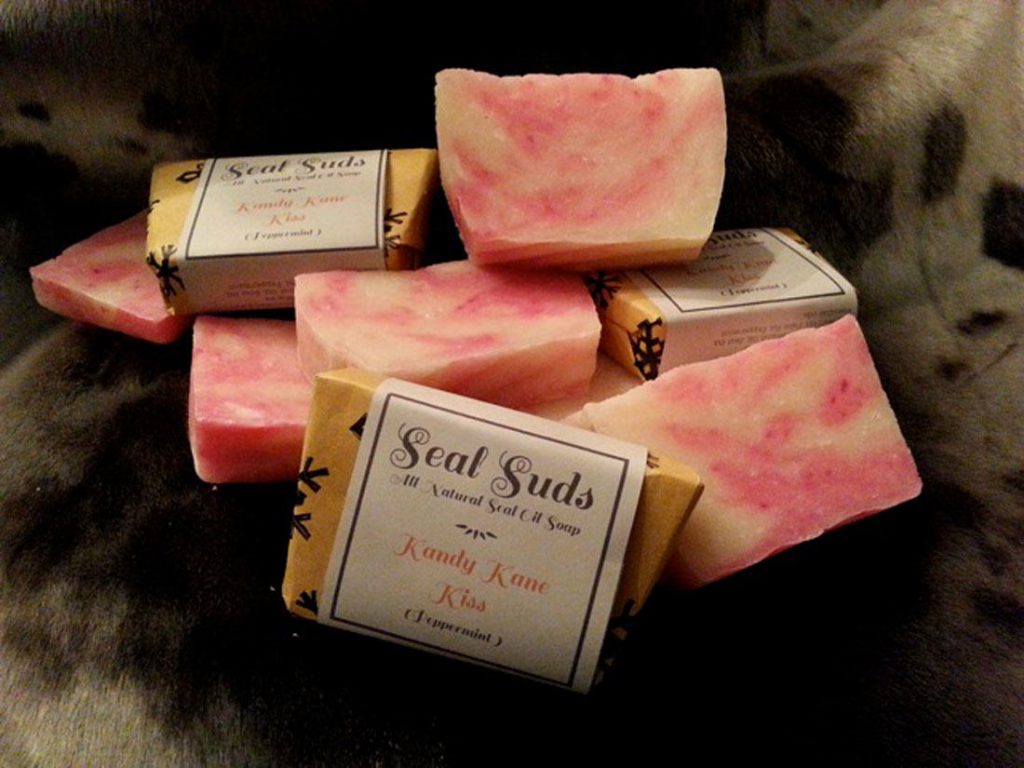
FROM OUR WEBSITE: IS IT ETHICAL TO PRODUCE, BUY OR WEAR FUR?
At a time when we, as consumers, are being urged to “care for our planet” and make environmentally-responsible choices, we…
Read More
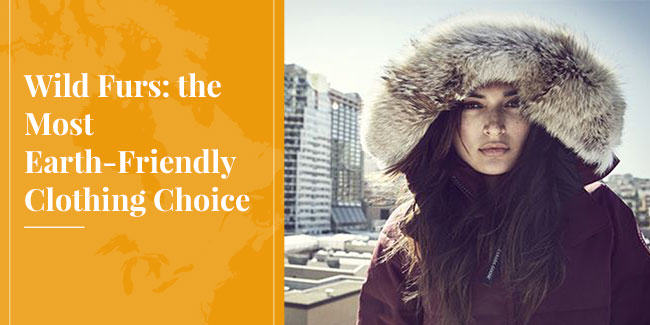
At a time when we, as consumers, are being urged to “care for our planet” and make environmentally-responsible choices, we should take a closer look at wild furs. And the closer we look, the more impressive are the environmental benefits we see. While all the furs we use today are eco-logical, wild furs are to clothing what “organic”, “free-range”, and “100-mile-diet” are to dinner.
Here are 5 top reasons why wild furs are an excellent choice for anyone who wants to adopt a “greener” life-style:
1. Like all fur, wild-sourced pelts provide a naturally warm, lightweight, durable, and ultimately biodegradable clothing material. After all, fur evolved over millions of years to become one of the most effective insulators we know. And, of course, fur is also remarkably soft, comfortable and beautiful!
2. The wild furs we use today come from abundant populations, never from endangered species. Trapping is strictly controlled by state and provincial governments to ensure that we take only part of the surplus produced by nature. Most species produce more young each year than their habitat can support to maturity. We can use part of that “surplus” without depleting the population. In financial terms, it’s like living on the “interest” that nature provides, without depleting our “capital”. This is known to environmentalists as “the sustainable use of renewable natural resources”, a key conservation principle promoted by the International Union for Conservation of Nature (IUCN) and other conservation authorities.
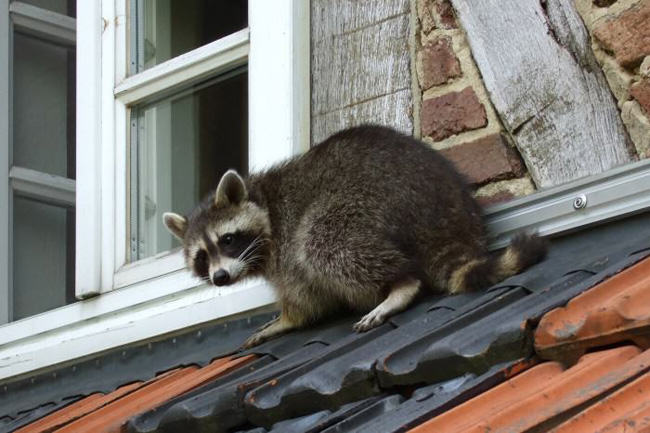
3. The populations of many furbearing species would have to be controlled even if we did not use the fur. Overpopulated beavers flood roads, fields, and forest habitat. Raccoon, coyote and fox populations must be controlled to protect sea turtle eggs, ground-nesting birds and other vulnerable or endangered species. Rapidly expanding coyote populations are also the number-one predator threat for sheep and cattle ranchers. Raccoons, foxes and skunks can carry rabies and other dangerous diseases into urban areas. When animals must be culled to protect property, to prevent the spread of disease, or for any other reason, it is more respectful to use them. Furthermore, without a market for fur, these management efforts would have to be financed by tax-payers.
SEE ALSO: WILDLIFE CONTROL EXPERT OR TRAPPER? WHO YOU GONNA CALL?
4. More than 35 years of scientific research and trap testing ensure that the most humane possible methods are used to capture furbearing animals. In fact, government-regulated trapping now often helps to reduce suffering, by maintaining healthier and more stable populations of wildlife than would occur naturally. If humaneness is a concern, modern trapping techniques are generally preferable to disease, starvation, and the “boom-and-bust” cycles that are nature’s ways of pruning back overpopulated beavers, muskrats, and other species. While farm-raised fur animals receive excellent care, some people feel more comfortable knowing that the animals we use live freely in their natural state until the moment when they are captured. In this sense, wild fur is the ultimate “free-range” clothing material.
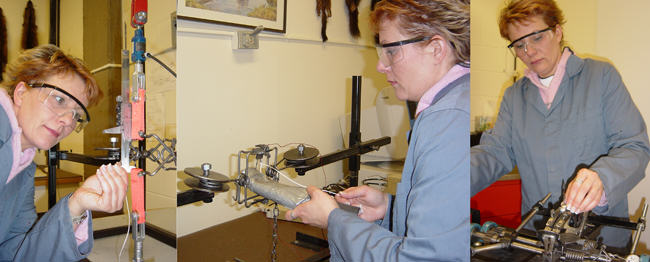
5. Many furbearing animals also provide food for aboriginal and other trappers and their families. Beavers and muskrats are important food sources for the Cree people of northern Canada. Raccoons, opossums, and other species are also eaten in many parts of North America. Animals that are not eaten by trappers and their families are returned to the bush where they feed mice, birds and other animals through the winter, when food is in short supply. Nothing is wasted.
Wild fur also provides important income for aboriginal and other people living in rural or remote regions where employment opportunities may be limited. Not least important: the income from wild fur depends upon maintaining natural habitat, and thus provides an incentive for maintaining wilderness areas. One of the unintended consequences of anti-fur campaigning is that, by eliminating markets (for sealskins, for example), they force aboriginal communities in northern Canada to open their territories to more oil and gas exploration, mining and other activities that can seriously disrupt wildlife and their habitat. In fact, trappers in many regions are working with government and industry to minimize the negative impacts of logging and other resource exploitation. For example, they lobby to maintain corridors and buffer zones of uncut timber around lakes and streams that wildlife depend upon, and they identify the nesting areas of eagles and other sensitive species so they can be protected. We all care about nature, but trappers are our eyes and ears on the land – the people who can sound the alarm when nature is threatened.
As this brief summary shows, wild fur is an excellent choice for anyone who cares about nature. Ironically, the “faux fur” and other synthetic textiles promoted by many “animal-rights” activists are usually made from petroleum, a non-renewable resource. But because most people – and most media – are now in big cities, the trappers’ story is rarely heard.
Eating Seal Meat: Vancouver Chef Puts Seal on Menu
by Truth About Fur, voice of the North American fur tradeEating seal meat is not something many of us have tried. It’s not a regular feature on restaurant menus, nor…
Read More
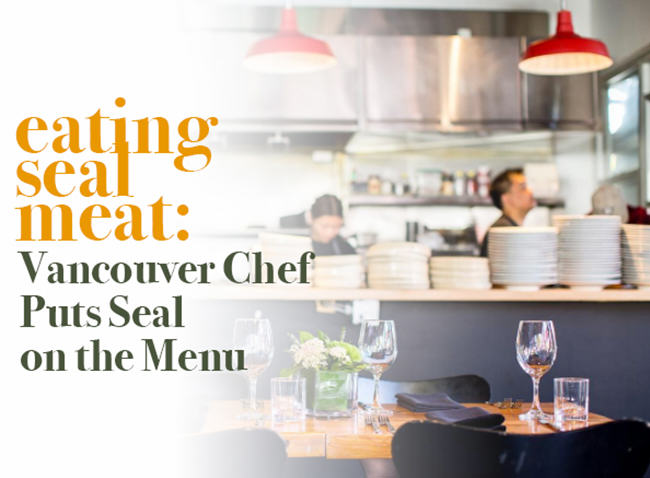
Eating seal meat is not something many of us have tried. It's not a regular feature on restaurant menus, nor is it abundant in grocery stores. Vancouver restaurant Edible Canada made headlines in January when it announced that its menu for the restaurant festival Dine Out Vancouver was going to feature seal meat.
The two dishes, a pasta dish featuring pappardelle with seal mince and a starter of seal loin served rare, caught the attention of media and culinary enthusiasts, but where there are seals, there are activists. Not only did protesters turn up outside the restaurant, they also went on a cyber attack, downgrading the restaurant’s reviews on Facebook by posting hundreds of one-star reviews (since reversed, to an extent, thanks to our loyal followers; see below).
We had a chat with Edible Canada's executive chef, Eric Pateman, described as “one of the leading ambassadors of Canadian cuisine”, about eating seal meat, protesters, and Canadian cuisine.
Truth About Fur: You knew there was going to be some backlash, so why did you decide to go ahead and put seal on the menu?
Eric Pateman: It was the right thing to do. Part of what we do as a business is define Canadian food culture and seal has such an important historical as well as present-day context to it. By not doing it, we would have been doing a disservice to part of what we do as a business, which is educating and informing people on what it is that makes Canada so unique.
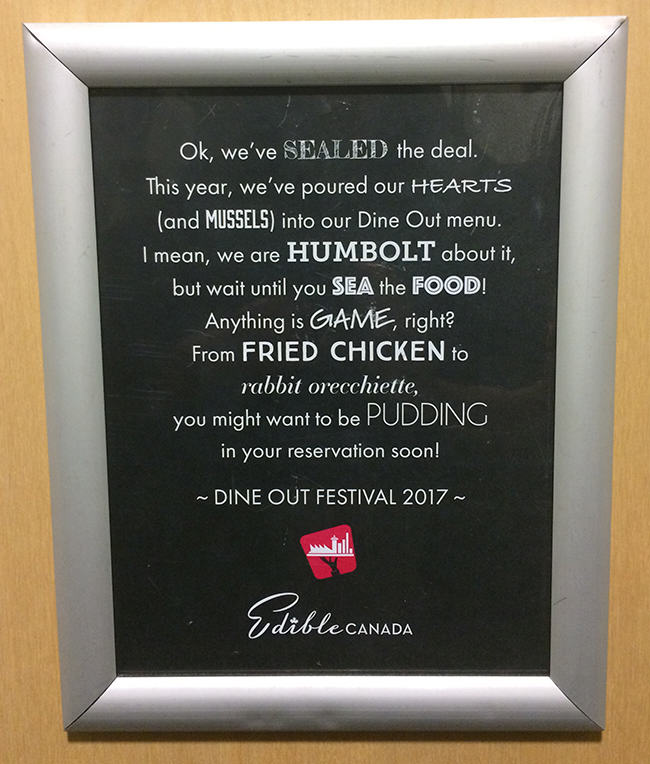
TAF: Did you have any plans in place to deal with the activists, or did you just deal with it as it happened?
EP: We definitely had had some conversations about what some of the potential backlashes could be, but we never anticipated the impact on social media that we saw. We expected some protesters, etc. ... The online impact was far more significant than we expected, but the in-person protests were less than we anticipated.
TAF: Well it is January, people don’t want to go outside, and it is much easier to criticize people anonymously from your computer.
EP: And most of the online attacks were international.
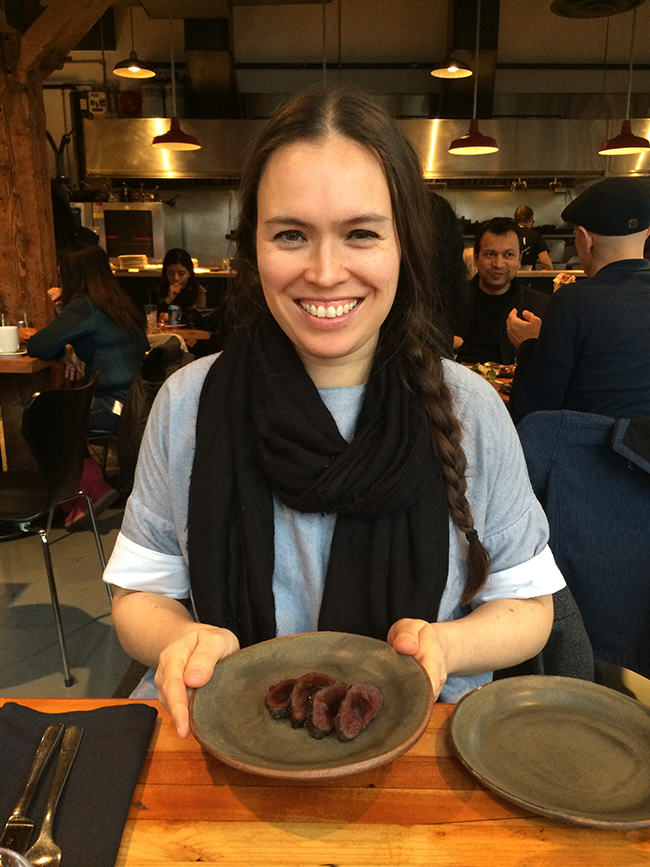
TAF: You posted on Facebook that the response to the seal meat was quite good. Can you talk about the feedback from customers?
EP: We had no idea how this was going to go, we thought it would be a great educational piece for the consumer. Obviously our customer base really likes the innovative and the obscure, and to try things that are truly reflective of our culture. When I looked at our numbers over the weekend, after the first three days [of the Dine Out Vancouver event] the seal dishes were the number one selling dish, by two to one over the next most popular dish, and the next was lamb heart. So we definitely attract a clientele who is interested in trying different proteins and dishes from across Canada.
[Editor’s note: lamb heart comes from a very cute, baby animal, but strangely there were no protests about that.]
We never anticipated that the pasta and the seal loin would do as well as they did. We didn’t make the call to add the seal loin to the menu until three days before Dine Out Vancouver. People were saying, “We really want to come in and try it, and we really want to taste it in its own right.” And almost every single table in the restaurant was ordering it. At the end of the day, the general perception has been incredibly positive. Ninety-five percent of the people who have tried it said “it wasn’t at all what I was expecting” to “it was better than what I was expecting.”
TAF: I expected it to be more liver-y. I didn't expect it to taste like steak.
EP: The big thing with seal is if you don’t cook it right, it does taste like liver and it does taste bad. It is very temperamental. I will be interested, when I am traveling across the Arctic circle to Newfoundland and going to the Festival of the Seal in the Magdalen Islands in March, to try other people’s interpretations of it. From what I have been reading online, the much more historical preparations are to cook it to death, and it comes across as a much more intense flavour, versus what we have done with the loin itself, keeping it rare. It mutes a lot of the flavours that come out with excessive cooking.
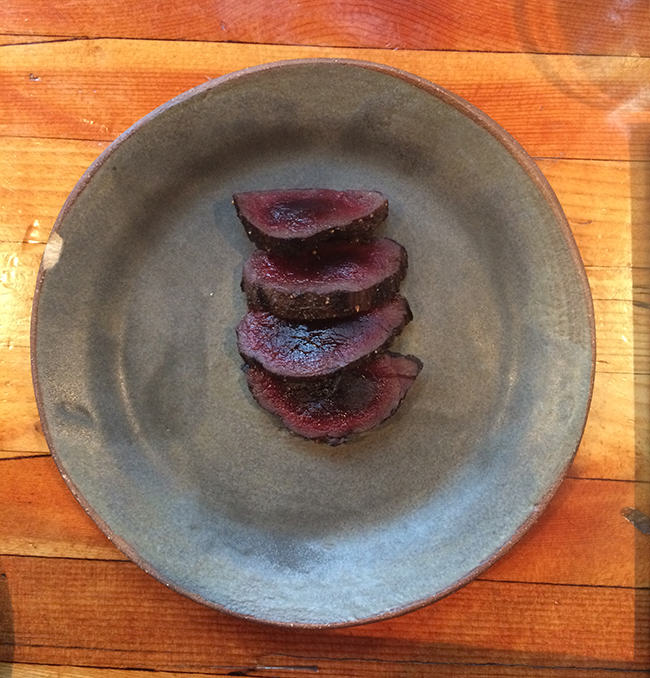
TAF: Do you think this is something you want to feature regularly?
EP: We are getting asked every single day whether we will keep it on our menu, and based on the response so far, absolutely. How we will keep it on the menu is yet to be determined. We are having guests ask for the loin in a larger portion - more than two ounces, more of a steak style. We might keep the pasta. We will sit down and evaluate that with the culinary team after Dine Out Vancouver and see what we want to do. Once the hunt is done and there is fresh seal meat, I can see us running a seal festival or an event around that.
TAF: I’ve frequently tried to find seal meat in restaurants across Canada and I have struggled to find it on menus. Have you had any feedback from other chefs, and do you think this might encourage them to put it on their menus?
EP: Absolutely. In the last week I have probably been contacted by five or six chefs, ranging from White Horse to Yellowknife to Calgary, and a few in Vancouver, all looking to get in contact with our providers. I can definitely see this starting to kick off. Someone had to be the one to jump in first, but I think we will start seeing other people adding it to the menus. We even had a fishmonger approach us if he could start carrying seal at his seafood store.

TAF: Throughout the dramas with the protesters, have you noticed how animal rights groups use the seal hunt as a money maker? Seals are abundant so there is no question about sustainability, and baby seals haven't been harvested since the '80s. What do you think of campaigners still using images of cute baby seals to raise funds?
SEE ALSO: EU SEALING POLICY IS HYPOCRITICAL, ANTI-DEMOCRATIC
EP: In all honesty, I don't know enough about that side of the industry. This was totally new to me, in terms of understanding a lot of the political ramifications and ties around it. Part of the reason I’m going to this seal festival, part of the reason I want to go out on the seal hunt this year, is to get a deeper understanding for myself personally. I had a couple of really good discussions both with the Humane Society and even PETA when they were protesting outside our restaurant the other day, we had a good chat and getting their take on things.
My job is to promote what Canada is, and I think one of the things that makes Canada so unique and special is that we are free to have a voice around things that are important to us, free speech, the ability to protest. I am not opposed to people doing what they are doing, though the cyber attacks were a little off mark, but I didn't have any issues with PETA showing up in front of our restaurant doing what they did. They have the right to do that. I hope to be far more educated by the summer with the hunt itself, really understanding it and all of the ramifications around it.
The Dine Out Vancouver event ends February 5th but keep en eye out for future seal meat specials at Edible Canada. And thank you to all the Truth About Fur followers who helped us get its rating back up on Facebook. Notorious seal-hunt opponent Paul Watson issued a call to his supporters to post poor (“1-star”) reviews, and 550 did just that, dropping Edible Canada’s average rating from 4.5 to 2.1 overnight. Truth About Fur and other responsible-use groups responded and within a week 5-star ratings caught up and pulled ahead. On the day of publishing this post, Edible Canada's average rating stands at 3.3. Check it out and post your review.
Sportsmen Must Unite to Protect All Hunting, Fishing, Trapping
by Jeff Traynor, trapper and editor, Furbearer ConservationI recently sat in on a conservation meeting in a sportsmen’s lodge outside Concord, New Hampshire. The topic for discussion…
Read More
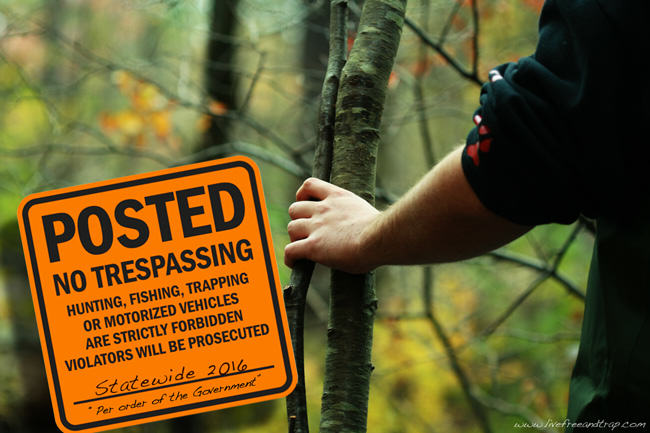
I recently sat in on a conservation meeting in a sportsmen’s lodge outside Concord, New Hampshire. The topic for discussion was the lack of camaraderie amongst sportsmen and women, and the toll this has taken on conservation and wildlife programs throughout the state and region. One man said his piece on what was wrong with the current state of hunting and trapping across America. “I’m going to say something that may offend some of you," he cautioned us, "but it needs to be said. Sportsmen groups are one of the most unorganized groups of people in the country.” There wasn’t a single rebuttal from anyone in attendance; everyone knew full well what he meant, and furthermore, what it means for the future of consumptive outdoor activities in the region and the country.
It’s a subject that not too many hunters and anglers recognize, or want to admit, but those of us in more “niche” activities like hound hunting and fur trapping know it all too well. Let’s face it, you may be a big-time duck hunter and passionate about your sport, but when a bill comes before your state legislature to restrict or ban bear hunting, are you as a duck hunter, going to take the time to write to your representative to save bear hunting when you know full well you’ll never hunt bear? I’m guessing the answer, nine times out of ten, would be “no”, and that's one of the reasons why consumptive outdoorsmen and women are constantly under scrutiny from anti-hunting and anti-consumptive organizations nationwide.
Decades ago this type of mindset was unheard of. If you hunted deer, chances were you also dropped a line in the creek for trout and trapped muskrats along the marshlands during duck season. In many states and provinces, this way of life still prevails as larger populations of rural folks hold tight to their outdoor self-reliant roots. But for many of us, the community of consumptive sportsmen has become fragmented. We are passionate about our own particular practices, but fail to recognize hunting, fishing and trapping as an all-encompassing benefit to conservation and outdoor recreation.
Divisions in the Ranks
Now I know there are plenty of you reading this and wondering what I’m talking about, thinking that it's only common sense to support all forms of hunting, trapping and angling. Unfortunately nowadays, your train of thought is in the minority, and this concept is seldom heard when the proverbial deer piss hits the fan.
Yes, we should support and commend one another for having the common sense to want this natural world managed and regulated as a resource for all consumptive practices. However, every state and province in North America has divisions within its hunting ranks. Many bird hunters don’t care for trappers; many deer hunters don’t care for hounds-men; many anglers don’t care for hunters. These divisions rise to the surface every fall, and sometimes disputes over wildlife management spill into clubs and departments, causing greater divides and offshoots.
When a bill or piece of legislation does come along threatening the current ways of hunting and trapping, it's usually only those whose hides get affected (pun intended) that spend time voicing opposition.
Meanwhile, the animal rights groups and “hands-off" environmentalists have a field day presenting themselves as the majority, when in reality this is clearly not the case.
Join Your Sportsmen's Group
So what exactly am I asking for? Am I seriously trying to convince every New Hampshire deer and pheasant hunter to show up at the next hearing on anti-trapping legislation? Well, frankly, in a perfect world that’s what I’d like to see, and I recall a time when that would not have been an outlandish request.
What I will realistically settle for is for all of you to join your local sportsmen’s group - not your local skeet club or shooting range, but your state organization dedicated to preserving hunting, fishing, and trapping for everyone. The Sportsmen’s Alliance for instance, is a national organization that champions such values. This group serves as a lookout to protect deer hunters and bass fishermen, as well as fur trappers, hound hunters, and turkey callers. While national groups like the Sportsmen's Alliance do an excellent job, we must also support one another at the state and regional levels. Almost every state and province has some kind of consumptive sportsmen’s group; Maine has SAM, New Hampshire has the NH Wildlife Federation, and so on from Vermont to California. These groups not only support all major forms of regulated hunting and fishing, but also serve as a bridge of unity between the different classes of these outdoor activities.
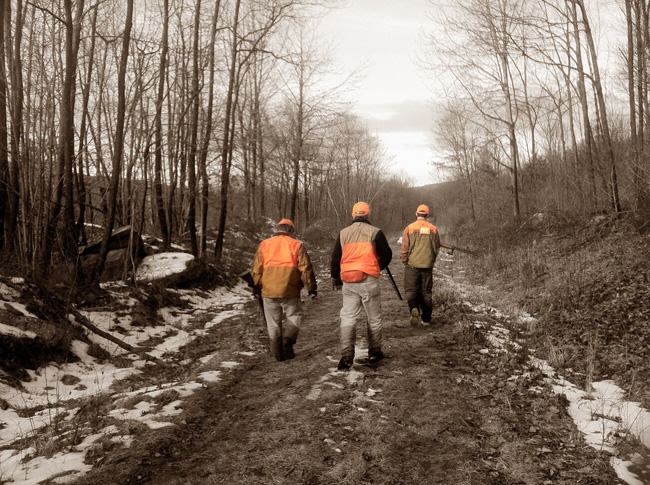
When each of you took your hunting or trapping education classes, you learned about concepts like carrying capacity, wildlife management and conservation. I can tell you the Primos hunting decal on the back of your F-250 doesn’t mean a thing if you don’t support the other aspects of conservation that go along with its meaning. It really doesn’t matter how much you spent on your duck blind, or which Pro-Staff you belong to - if you aren’t willing to recognize and support the other aspects of wildlife conservation, such as fur trapping and bear hunting, your Real-Tree camo pajamas are nothing more than a fashion statement. More than 90 million U.S. residents (16 years old and above) participated in some form of wildlife-related recreation in 2011. With numbers like this, it’s a downright embarrassment that we must constantly fight to keep trapping and hunting relevant today.
Deceitful Anti-Hunting Groups
Despite what anti-hunting activists may say or think, I know lack of support for these “niche” activities isn’t due to lack of individual sympathy for the cause, but rather a lack of motivation to see the fight through. This is where we all, as outdoorsmen and women, must stand together against those who wish to abolish all forms of hunting and fishing. If you don’t believe your brand of outdoor hunting could be targeted, take a look at the current headlines to get a snapshot of how anti-hunting groups deceitfully operate. They know how difficult it is to push a man off his stool. They know it's much easier to whittle away at each supporting leg of that stool when he’s not looking, and watch him fall on his ass in sheer shock and surprise!
Keep in mind these organizations don’t protest hunting and attempt law changes on principle. Their primary motivation is donations. Take a look at any of the anti-hunting groups like HSUS, PETA and Furbearer Defenders, and you’ll see their websites plastered with “donate-now” buttons. They parade state-to-state crying injustice, corruption and animal cruelty while soliciting for donations. Once the deed is done, and they’ve won the argument, they’re on to the next state to suck the life out of their outdoor conservation groups. The wildlife these groups claim to support end up suffering in their wake as they continue to follow the money. Its common knowledge that most of the people who speak against hunting at these state hearings are paid to be there – it’s much more motivating to “save the animals” when you’re collecting a large paycheck in the process. But instead of standing and fighting these anti-hunting groups, sportsmen are busy pushing their neighbors under the bus in the hope these groups will move on if trapping and bear hunting are banned. This is a huge mistake, as even the most basic research on these groups will show this is not their end game. Staten Island is already experimenting with controlling its deer population by castrating bucks rather than allowing hunting; it’s happening right in front of your eyes and I’m sorry to say the “Redneck pride” sticker on the back of your truck isn’t going to stop it.
It’s not all doom and gloom; there is a light at the end of this ever-growing tunnel. You can start by becoming an active member of your local sportsmen’s club and keeping an ear to the wall for anti-hunting and trapping legislation. Find out who your local district and state representatives are and let them know you are a hunter or trapper. Whether they’re Democrat or Republican, conservative or liberal, most representatives listen to what their constituents are saying. Sending a handwritten letter introducing yourself and your outdoor activities is a good start to breaking the ice before legislation is introduced. It doesn’t take a lot of time either - I work a full time job, maintain and run a pro-trapping website for free, and take an active role in my local conservation groups with time still left over to hunt and trap!
To summarize, whether you hunt to put venison in the freezer, fish for sport, bird hunt with dogs or set traps for natural fur garments, you are an integral part of the North American Model of Wildlife Conservation. Your support is needed as our society is overcome by tablets, smart-phones, self-driving cars and Kardashians. Our self-reliant ways of life are ALL in jeopardy as habitat loss and out-of-touch citizens continue to constrain and restrict our activities. It’s time we start pushing back and regain our freedoms as fixtures of the natural world. United We Stand, Divided We All Fall.
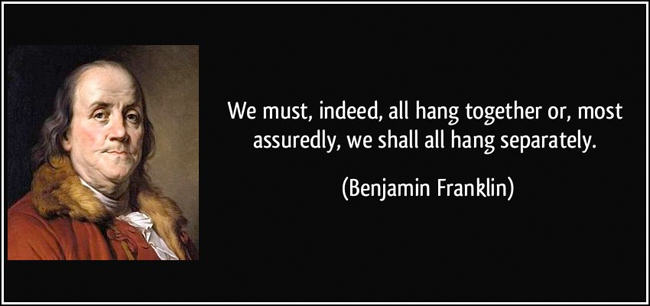
FOLLOW JEFF TRAYNOR'S "LIVE FREE AND TRAP" ON:




Born Free USA Campaign Misrepresents Trapping
by Alan Herscovici, Senior Researcher, Truth About FurA recent on-line, anti-trapping rant by Born Free USA boss Adam Roberts (“What kind of person still traps wild animals?”, Huffington Post,…
Read More
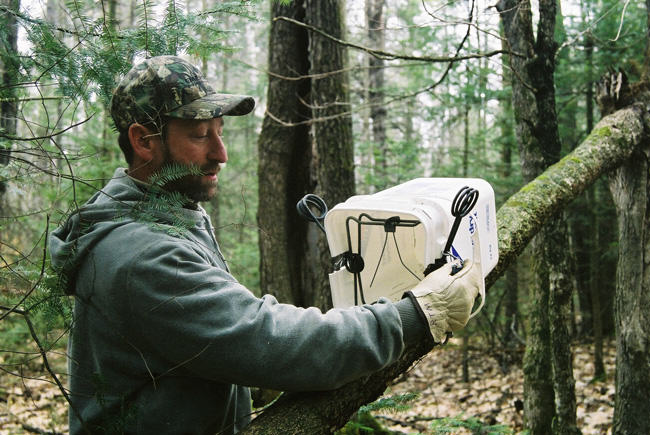
A recent on-line, anti-trapping rant by Born Free USA boss Adam Roberts ("What kind of person still traps wild animals?", Huffington Post, Sept. 7, 2016) underscores how trappers are on the front line in the war against humans using animals – a war in which the weapons of choice are misleading images, inflammatory rhetoric, and exploiting the information gap between rural and urban cultures.
Roberts' attack drives home how important it is to explain, again and again, the vital role trappers play in responsible wildlife management and conservation.
Like other "animal-rights" groups, the folks at Born Free rage against a wide range of animal-use activities. This time, as part of their "Victims of Vanity 2" campaign, they are promoting an “undercover” trap-line video showing “atrocities” that they claim “occur regularly across America”.
“What kind of person purposely destroys a beaver dam and sets a ‘wall of death’ of Conibear traps," asks Roberts, "knowing that the unsuspecting beavers will return to repair their handiwork – only to be possibly smashed across their abdomens and drowned?”
The insinuation is that such traps cause terrible suffering. Born Free's own video, however, shows beavers that have clearly been struck by the trap bar across the back of the neck, breaking cervical vertebrae and causing rapid death, just as this quick-killing trap is intended to do. These traps were developed through several decades of (on-going) scientific research to provide the most humane possible methods for controlling wildlife populations.
North America’s world-leading humane-trap research program has provided the scientific basis for comprehensive state and provincial trapping regulations, trapper-training programs, ISO standards, Best Management Practices, and the Agreement on International Humane Trapping Standards.
SEE ALSO: Neil Jotham: A life dedicated to humane trapping
Thanks to this pioneering work, the time-to-death produced by quick-killing traps like those shown in Born Free's video is now measured in seconds. Roberts knows, however, that most of his readers live in cities and have little real contact with nature. People who find their meat neatly wrapped in cellophane on grocery store counters are easily shocked by pictures of dead animals, no matter how humanely they were euthanized – especially when cued with sufficiently emotional rhetoric.
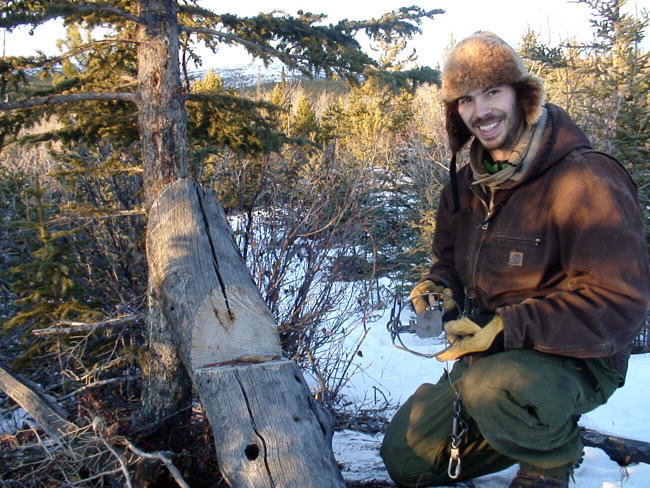
Similarly, the live-holding devices used for capturing larger predators – like the coyote shown in Born Free's video – are not diabolical instruments of “torture”. Modern, live-holding foot traps are used by wildlife biologists to capture and release – unharmed – wolves, lynx, river otters and other animals for radio-collaring or reintroduction into regions where they were previously extirpated. To claim, as Roberts does, that such traps “have remained relatively unchanged for 400 years” is nonsense.
Should We Kill At All?
But what about the bigger question Roberts implicitly raises: should we really be killing wild animals at all?
In fact, there are many reasons why wildlife populations often must be managed. Overpopulated beavers can completely “eat out” vegetation in their region; the population will then crash and there may be no beavers at all for many years. Regulated trapping can smooth out these boom-and-bust cycles, maintaining healthier and more stable beaver populations. This is one reason why biologists believe there are now as many beavers in North America as there have ever been. There can, however, be too much of a good thing: beaver dams in the wrong places can flood roads, fields, and forest habitat. When your basement (driveway, back yard) is flooded, who’re ya gonna call: Mr. Roberts ... or your local trappers’ association?
Meanwhile, coyotes are the number-one predator problem for sheep and cattle ranchers, and many states and provinces have been obliged to offer bounties to keep their populations in check. Coyote, fox and raccoon populations are also culled to protect endangered ground-nesting birds or sea-turtle eggs. Overpopulated foxes, skunks and raccoons are prime vectors for rabies and other diseases that can be transmitted to humans and pets. For these and many other reasons, there will always be a need for trapping, whether or not anyone buys fur. Without a market for fur, however, these management efforts would be paid for by the government – i.e., by tax-payers – as they now are in many parts of Europe.
SEE ALSO: Why fur is the ethical clothing choice
Trappers protect nature in other ways that are not often publicly recognized. While we all “care” about nature, most of us now live in cities. Trappers are our eyes and ears on the land, sounding the alarm when nature is threatened by inappropriate resource extraction or industrial activity. Trappers' associations across North America are on the front lines to ensure that forestry practices respect the needs of wildlife, for example by leaving a swath of uncut trees along watercourses. And, like the canary in the mine, trappers are the first to spot changes such as reduced reproduction rates among mink that may signal industrial pollution upstream. Harvesting data, including the sex and age distribution trends, provide vital information about the health of our wildlife populations.
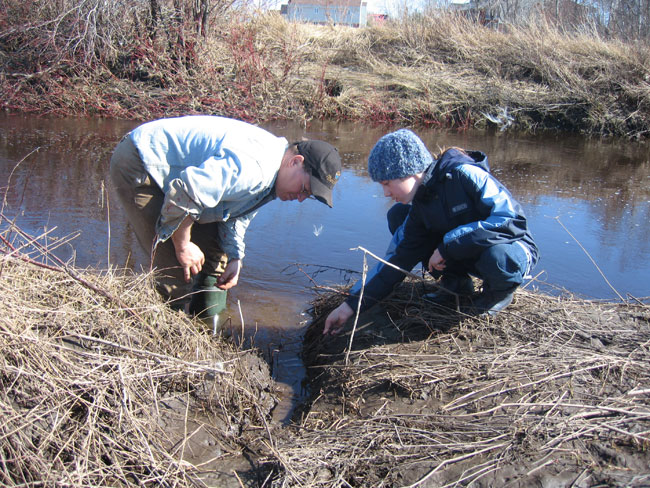
Most important of all, nature is not a museum. Most wildlife species produce more young each year than their habitat can support to maturity. The ones that don’t survive feed those that do. We are part of nature and we too can make use of the surpluses that nature produces – year after year, generation after generation – so long as we protect the habitats and ecosystems that provide those surpluses. This is called “the sustainable use of renewable natural resources”, a central conservation principle promoted by the International Union for Conservation of Nature (IUCN) and other conservation authorities. (By contrast, the synthetic materials that animal activists would have us wear are usually derived from petroleum, a non-renewable resource.)
Animal Abuse
Does all this give us the right to abuse animals? Absolutely not.
The Born Free video also shows a trapped coyote being kicked, prompting Roberts to ask, "What kind of person watches a tethered and helpless coyote writhe in pain and distress, unable to move because of the intensely unforgiving steel jaws clamped to her paw, kicks her in the side, and then finally shoots her in the chest so that her lungs fill with blood, and she dies a miserable, suffocating death?"
Most trappers would be disgusted by this scene. There is no excuse for kicking an animal, ever. Furthermore – Roberts' "intensely unforgiving" rhetoric aside – every trappers' association and trapper-training manual teaches that live-trapped animals should be killed quickly and humanely with a direct shot to the head. But this completely unacceptable behavior of one individual does not give Roberts or Born Free the right to smear the reputations of more than 200,000 North American trappers.
On the contrary, as society becomes more interested in protecting our natural environment, it is time that we learn more about these remarkable and knowledgeable men and women – the small minority among us who continue to live close to the land.
What kind of person still traps today? Far from the grotesque caricatures that animal activists like to portray, in many real and practical ways, today’s trappers are the true guardians of nature.
10 Cool Facts You May Not Know About Fur
by Truth About Fur, voice of the North American fur tradeCOOL FACT #1: Fur may have saved the human race New research suggests humans (Homo sapiens) survived the last Ice…
Read More

COOL FACT #1: Fur may have saved the human race
New research suggests humans (Homo sapiens) survived the last Ice Age and Neanderthals didn’t because humans were serious about fur clothing. Animal remains around Neanderthal sites lack evidence of furbearers, while human sites have fox, rabbit, mink and notably wolverine - the same fur still preferred today by Canadian First Nations for hood liners.
COOL FACT #2: Everyone's heard of the California Gold Rush, but how about the California Fur Rush?
In the early 19th century, trappers came from far and wide to the US west coast to harvest huge populations of furbearers. It was these trappers, not the gold prospectors who followed, who opened up the west and put San Francisco Bay on the trade map. But no one remembers because no one named a football team after them. Go 49ers!

COOL FACT # 3: Beaver butts are used in food flavouring
Next time you see the words "natural flavouring" on a food package, it might be referring to Castoreum, secreted from the castor sacs of beavers located between the tail and the anus. Usually it's used to simulate vanilla, but it can also pass as raspberry or strawberry.
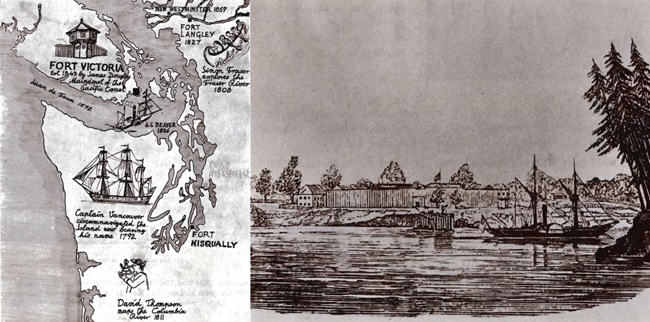
COOL FACT #4: The fur trade determined much of the Canada-US border
The search for fur drove Europe's exploration and settlement of North America, and many of today's towns and cities began as fur-trading posts. In fact, much of the border between Canada and the US traces the territories once controlled by Jacob Astor’s American Fur Company and the Montreal-based North West Company.
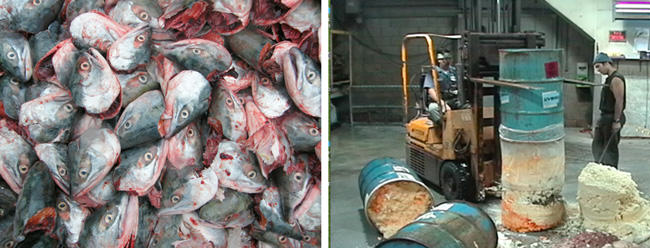
COOL FACT #5: Mink farming plays a key role in our food chain
Have you ever wondered where all the animal leftovers from human food production go? Fish heads, chicken feet, expired eggs, spoiled cheeses? If you live in fur-farming country, chances are they go to make nutritious mink food. And the mink manure, soiled straw bedding and carcasses are composted to produce organic fertiliser to enrich the soil, completing the nutrient cycle to produce more food.
COOL FACT #6: Mink wastes provide biofuel
In Nova Scotia, Canada, pilot projects are transforming mink wastes into methane for bio-energy production. In Aarhus, Denmark – the country that produces the largest number of farmed mink – the public transit buses already run on mink oil.
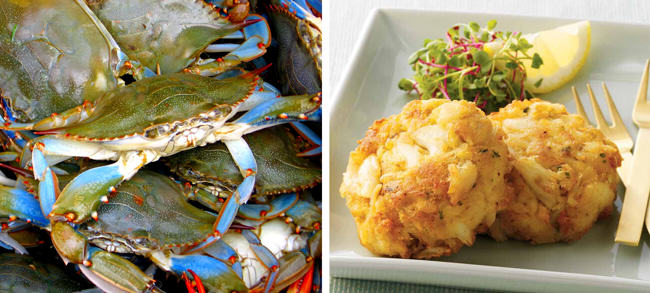
COOL FACT #7: Mink carcasses make great crab bait
Crabs will eat just about any seafood you offer them, but so will seals and sea lions, and they'll trash your crab pots to get at it. Enter mink bait! Crabs find their food by smell, and apparently the smellier the better because they love mink musk. But seals and sea lions can't stand it and will give your pots a wide berth!
COOL FACT #8: Canada's beaver population has never been bigger
The national animal of Canada has been prized for its luxuriant fur for hundreds of years, yet wildlife biologists believe there are as many today as there were before Europeans arrived. They also believe coyotes, foxes and raccoons are more populous now than ever. Truly modern trapping, regulated to allow only the removal of nature's surplus, is a perfect example of the sustainable use of renewable natural resources!
SEE ALSO: Abundant furbearers: An environmental success story.
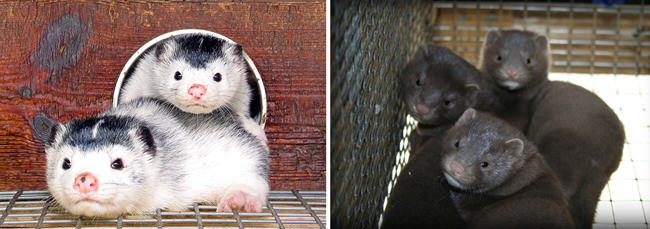
COOL FACT #9: Farmed mink enjoy company so farmers house them in pairs
After being weaned from their mothers, farmed mink are often raised in pairs, preferably a brother and sister, and sometimes even threes. Farmers have learned that keeping siblings together results in calmer and healthier mink.

COOL FACT #10: Fur garments are very labour-intensive
Fur garments are created individually, with all the cutting and sewing done by hand. Not counting all the work involved in producing the pelts, an “average” mink coat might take 35-40 hours of hand work, while an intarsia sheared beaver by Zuki could take 100 hours. That's longer than it now takes to assemble a car!
BONUS FACT: Animal activists have no sense of proportion
Each year, North Americans use about 7 million animals for fur. That's one sixteenth of one percent of the 12 billion animals they use for food. Yet animal activists focus more attention on the fur trade than on all other livestock industries combined. Go figure!
Sportsmen’s Alliance on Today’s Trapping Challenges
by Alexandra Suhner Isenberg, former Online Communications Director, Truth About FurThe Sportsmen’s Alliance is a US organisation that protects the outdoor heritage of hunting, fishing, trapping and shooting in all…
Read More
The Sportsmen’s Alliance is a US organisation that protects the outdoor heritage of hunting, fishing, trapping and shooting in all 50 states. Between fighting in the courts, political lobbying, and countering campaigns by animal activists, they are kept busy. We talked to Vice President Marketing and Communications Brian Lynn about trappers, hipsters and sound bytes.
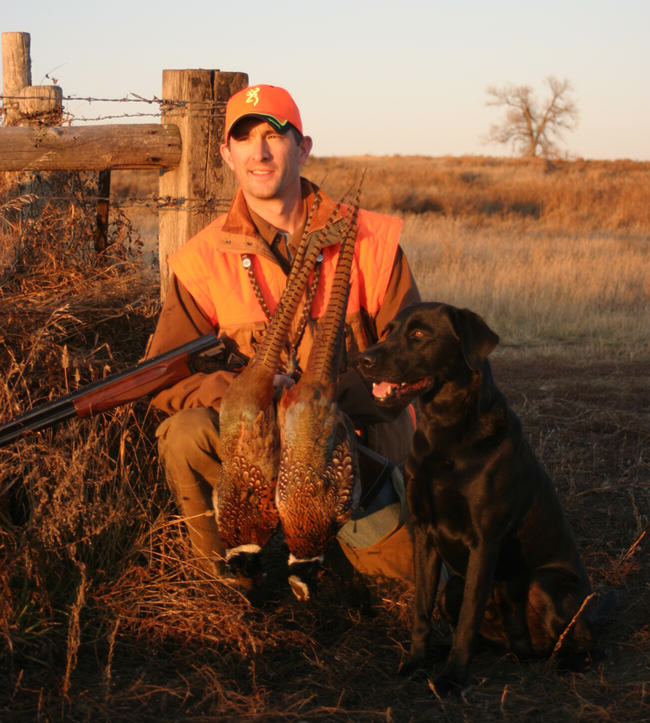
Alexandra: What percentage of your members are trappers versus hunters and fishermen?
Brian: I’d say somewhere between 10 and 20%. It’s not a huge number, but the trappers are the most active, passionate, and engaged audience there is.
Alexandra: Interesting you say that, because we think that too.
Brian: Trappers are the ones on the front lines. They are constantly under attack.
Alexandra: Are you referring to the amount of legislation that people are trying to put into place to try and ban trapping?
Brian: Yes. Animal rights organisations, legislation, the ballot box – trappers are constantly under attack. Whether it is changing the seasons, eliminating the seasons, or regulating traps, they are getting hammered left and right.
Alexandra: Do you think that trappers are getting attacked more because they are fewer in number? Or perhaps because in the US hunting is more associated with a weekend pastime?
Brian: It is both. There aren’t as many trappers, so it is more of a fringe endeavour. Also it lacks the idea of a sport – of you versus the animal. To the uninitiated, it just seems like you are going out there, putting some bait out, and whether a wolf, bobcat, bear, or your dog comes along, they get snapped up and killed cruelly. It looks barbaric, and it is a hard sell for us to protect. It is an easier sell to misrepresent. People already are ignorant about it; urban people are like, “You do what?” It is a harder thing to protect because of the ignorance, and it lacks the perception of sport and the “you versus the animal.”
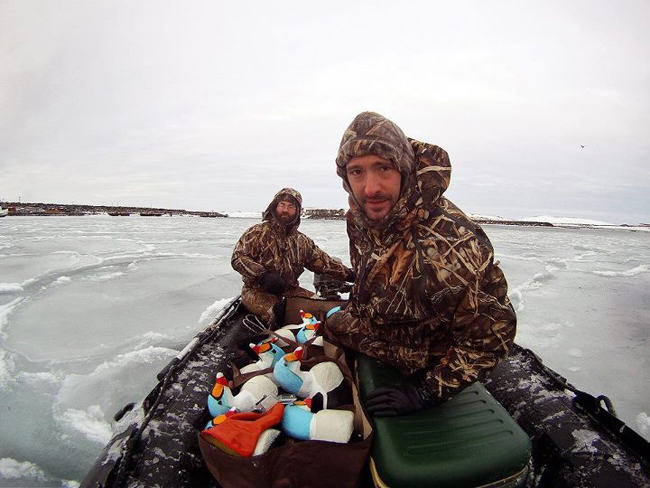
Active or Passive Management
Alexandra: It's interesting how urban folk don’t mind trapping when there’s a coyote eating their cats, or beavers flooding their home.
Brian: That’s the whole thing. People say, “This doesn’t seem fair, that doesn’t sound right,” until it impacts them. Once the deer come in and start eating their petunias, now they're mad. Or they're hitting deer with their car. Now they want something done. Don't kill the bears until the bears start eating your kids. It boils down to active management versus passive management.
We did a piece on defensive trapping a couple of months ago in our newsletter, and without trapping, state agencies will spend hundreds of millions of dollars on trapping nuisance animals and flooding. Nobody understands that until it happens. The animal rights activists try to couch it as, “We don't need to manage populations." They try to pass off the Disney idea that “nature will balance itself”, which never really happens. But even they are saying passive management is ok. When the mountain lion becomes overpopulated and one starts eating their cats, then it's ok for the state to come in and kill that one lion. Well, it costs a ton of money, and it's not fixing the problem. With active management, you are mitigating the booms and busts and managing them actively with hunting and trapping. The animal rights groups just want to let everything go wild, and passively manage it when it becomes an issue with humans, which is just not going to work because we see disease, starvation, plus human-wildlife conflicts.
Alexandra: What are some of the biggest issues that you are dealing with right now, and have the kinds of issues evolved much over the past 20 years?
Brian: They go in waves and trends. In the 1980s, animal rights groups went after bow hunting, in the ’90s they went for mountain lions and some bear-hunting tactics. Last year we saw a lot of dog-related activity: kenneling, breeding, selling legislation. A lot of it is aimed at puppy mills, but if enforced to the letter of the law, it will stop hound hunting, kenneling, or selling those dogs.
We also saw a lot of apex predator issues – black bears and wolves. And now we are seeing them setting the table to come back for more of what they attacked in the ’90s - black bears and mountain lions in the west, and the Great Lakes wolves.
They hit something hard, in multiple states, for a couple of years, then let it rest. They let the social consciousness of the non-hunters absorb it a bit, they’ve made it an issue. Then they let their fundraising base rest, then come back and hammer it again several years later. It makes for a better news story again. Then it seems like a big issue that keeps coming out so they can get more funding, and it psychologically resounds with the public. “Oh, this is an issue, we need to do something about this!”
Great Lakes Wolves, Maine Bears
Alexandra: What are some of the activities that you do to fight the activists, and which campaigns have been successful?
Brian: Right now we are the lead on the Great Lakes wolves lawsuit. It is the Humane Society of the United States vs. the Sportsmen’s Alliance, the Department of the Interior, and the State of Wisconsin. So that is one we have been fighting for several years, and that should be moving through the court system, and we are appealing the last decision that was made in December 2014.
One of our more successful campaigns was the Maine Bear Ballot issue in 2014. The HSUS decided to go after bear hunting in Maine and hired a California firm to collect signatures and force it onto the ballot. The HSUS just self-funded the whole thing. If that had been successful, it would have basically put an end to bear hunting in Maine. It would have removed the use of traps, bait, and hounds to hunt bears, and that is 93% of the harvest. We went in, organised the grass roots groups, bought air time, created the messaging, and we ended up beating them by 8 points. And there was a couple of lawsuits out of that, that we fought and were successful in. We were successful all the way around and have a good base set up to protect it again, should they come back, and they have stated they are coming back again to stop it.
The thought is that they will just go after hounds and traps, because few people use these, so most people don’t care. This is when we get into apathy within our own ranks. If HSUS removes 85% of its opposition and 85% of its opposition’s funding, those who remain make easier targets.
"Sticking Up for One Another"
Alexandra: Some graphics in your social media send a message about uniting hunters, fishermen and trappers. What is the thinking here?
Brian: We need to be sticking up for one another, despite method of take. Even if you don’t participate in trapping and you don’t use bait, we can’t stand around and say, “That’s doesn’t affect me.” Once hound hunting falls, once bait hunting falls, once trapping falls, they are coming after what you do want to do. We need to be united regardless of how we are participating in these activities.
Alexandra: What percentage of Americans do you believe support hunting, trapping and fishing, and how many are opposed?
Brian: Hunters and anti-hunters are about the same size, 5-10% of the population. And all of the polls show that 75-80% of the general public support hunting as a management tool. That’s great. But the problem is that all that support goes right out the window as soon as emotion gets into it. People's minds are changed really quickly if they are shown an animal flopping around in a trap or a dead trophy shot. We move from the logical “That makes sense, I support hunting,” to the emotional “Oh, but I don't support it in this instance. It seems cruel.”
The other side can just throw words around like “slaughter” and sway those non-hunting voters.
Our biggest challenge is telling our story, why we have to do it, why it makes things better, the funding of conservation, managing populations, habitat, carrying capacity of the land. That’s a long story which can be boring if you aren’t into it, and if there is legislation or a ballot initiative, and a news anchor puts a microphone in your face and you try and explain carrying capacity of the land and funding of conservation, it is long, boring, and not sound-byte stuff. Then they ask the other side why we need to stop it and they say, “It's cruel, they are slaughtering animals with babies.” There’s your sound byte.
"Hipster Deal Big Move Forward"
Alexandra: Have the demographics of your supporters and members changed? There is a hipster trend now, with people doing things themselves, growing their own food and maybe hunting. They were traditionally more on the left of the political spectrum, whereas hunters tend to be on the conservative side. Do you see this new demographic supporting outdoor activities?
Brian: We are seeing a bit of a bump, which is great from a branding and messaging perspective. This is important for the hunting and trapping industry in general, but here at the Sportsmen’s Alliance we are very engaged, political, more hardcore. The new people coming in are a more holistic type of person, who may not be political.
For the broader industry, though, the whole hipster deal has been good. From the perspective of acceptance within the mainstream, those people are sharing with other people, within city life. It is about taking responsibility for their food, and them relaying their message in a way that their friends can understand. That’s where I see it as being the biggest move forward for the industry. How do you reach someone in LA? We aren't going to reach some hipster in LA, but some guy at an LA party who went out, harvested his own food and killed a deer, that is going to do more good than anything we are doing as an industry to disseminate the proper message.

Alexandra: Do you cooperate with a Canadian counterpart?
Brian: There is some run-over, but nothing official. In Maine, we are involved in two lawsuits on trapping Canadian lynx. In Maine, Canadian lynx are on the Endangered Species List, but north of the border they are not.
There are incidental take permits, and a certain number of Canadian lynx can be caught in traps without the trapper or the state being in violation of the Endangered Species Act. The HSUS is trying to stop that; they are trying to get the incidental take permits revoked. If they succeed, that would mean that anywhere there is an endangered species of any kind, trapping can be stopped. If you take it a step further, anywhere there is an endangered fish in a river, you could apply the same logic. You can’t fully control what steps into a trap, therefore you can’t trap anywhere there is an endangered species, just like you can’t always control what is going to bite your hook, therefore no one can fish anywhere there is an endangered fish. So that’s a lawsuit we are involved in in Maine.
"Educate Those Not Within Your Group"
Alexandra: Is there any advice you have for trappers about protecting their rights, proactively?
Brian: They need to educate non-trappers about what they do: about how trapping is regulated, how hard it is, what you do to prevent non-target by-catch. People need to understand that, and it is not the people that are already in your social groups, it needs to be the non-trapper or the hunter that doesn’t understand it, so you can help eliminate that issue of hunters not caring. For example, there are a lot of bird dog hunters that hate trapping because traps will be out during grouse season and they are worried their dogs might get snagged up in them. We need to try and educate those people. It is all about educating those not within your group.
As for state and provincial organisations, they need to start collecting funds and putting these aside. This is something we are saying in Maine, start a war chest, because the attack is coming, it is just a matter of time. The HSUS is so rich they can self-fund any campaign they want to. They are a $130-150 million a year organisation, so they can just decide “this is where we are going to go, and we will spend $3 million.” If HSUS comes and you sit there fundraising for the first six months, that's a six-month head start they have in swaying public opinion. If you can hit the ground running, and you already have a war chest, you are better off. That’s hard for groups to do, though, because unless there is a bogeyman right there, those funds start to look very attractive to dip into and use for other things.
Alexandra: Thank you for taking the time to speak to us!
For further reading, check out this great Sportsmen's Alliance content:
The Anti-Hunter’s Playbook
A Defense of Trapping (full issue)
A Defense of Trapping (article)
Why All Sportsmen Need to Defend Trapping
Introducing Youth to Trapping
And connect with them on their website, Facebook page, Twitter, and Youtube.
Alcide Giroux: My First 60 Years Enjoying Nature as a Trapper
by Alan Herscovici, Senior Researcher, Truth About FurTrue life stories of a Métis trapper and his love for the land, his family and friends A primary goal…
Read More
True life stories of a Métis trapper and his love for the land, his family and friends
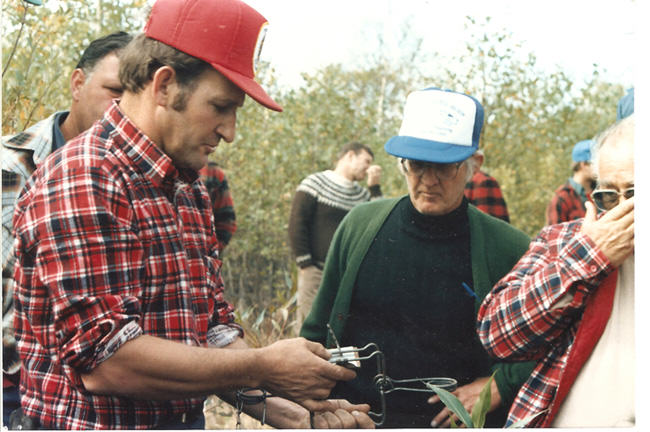
A primary goal of Truth About Fur is to give a voice to the real people of the fur trade. So what a pleasure it is to tell you about a newly published autobiography by one of Canada’s foremost trappers and trapping advocates, the legendary Alcide Giroux.
My First Sixty Years Enjoying Nature as a Trapper promises, and delivers, a passionate and epic tale of a life lived in close harmony with the land: hunting, fishing and trapping. And thanks to Alcide's extraordinary memory, he shares many wonderful adventures with us in vivid detail.
God's Country
The story begins in December 1951, near Sturgeon Falls, Ontario. Alcide was just six years old when his father moved their family onto the old homestead his grandfather had cleared and built in the early 1920s. There was no electricity or indoor plumbing, and young Alcide and his siblings had to cross the Sturgeon River in a small homemade boat before walking to school – a walk that provided opportunities for the young Alcide to snare rabbits to complement the moose and beaver in his mother’s stew pot. It was God’s Country back then, Alcide tells us, with wilderness and wildlife all around. Their trap lines began at the farmhouse door.
A few years later, Alcide’s Dad built a remarkable suspension bridge to facilitate the family’s commuting. “We had so many curious and nosy visitors; they all came to see the 8th Wonder of the World ... well the 8th wonder of River Valley!” Alcide recalls.
I enjoyed reading about this remarkable DIY engineering feat all the more because I walked across this same bridge many years later when I visited Alcide’s trapline, in the 1980s.
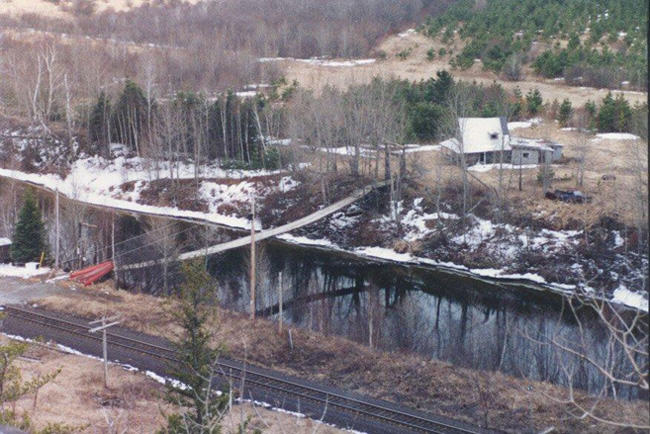
In the pages of his new book, Alcide pays tribute to many kind and talented woodsmen, but none more than his own father, “a great trapper with a built-in GPS in his brain.” Philippe Giroux was a Métis who instilled in his sons the importance of respecting the animals they depended upon, which meant trapping as humanely as possible. “Because we only had leg-hold traps back then, Dad showed us how to build underwater sets that ensured a quicker death for muskrats, mink and beaver.”
Alcide Giroux clearly learned his Dad’s lessons well; he became one of Canada’s foremost advocates for humane trapping. By the time he was 30, in 1975, he was writing articles in trappers’ magazines and leading workshops across Ontario and beyond, promoting the importance of researching and implementing better trapping techniques.
"I Had Gained Their Trust"
In 1980, as newly-elected president of the Ontario Trappers Association (OTA), his first speech called on trappers to take the lead in humane trapping, rather than have changes imposed on them by others. He remembers that his beloved wife, Pat, sitting at the back of the hall, was worried about how this call for change would be received. But Alcide’s sincerity and straight talk won the day.
“There were no hard feelings, no arrows thrown, but lots of applause and many handshakes," recalls Alcide. "I could breathe again; I had gained the trust and confidence of my fellow trappers.”
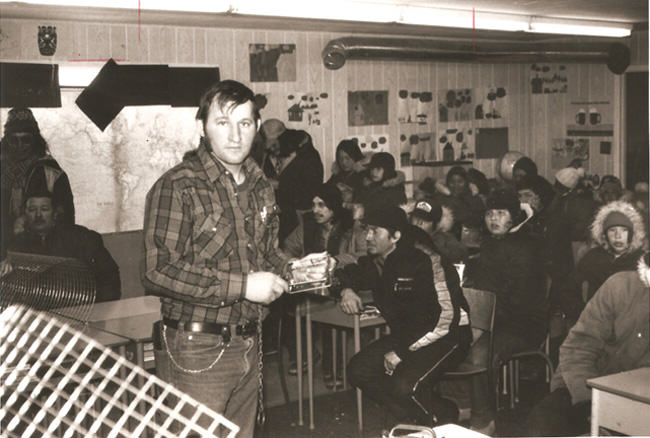
When the Fur Institute of Canada was created in 1982, to implement recommendations of the Federal-Provincial Committee on Humane Trapping (1974-1981), Alcide became a founding member, and later vice-chair. Accompanied by Pat, he travelled the world to lend his expertise to trap-research and conservation meetings in New Zealand, Europe, Louisiana, Australia and elsewhere. When scientists, politicians or journalists wanted to see a trap line first-hand, more often than not it was Alcide and Pat who received them.
Alcide’s story bursts with good humour and a passion for life, whether he’s describing the orphaned bear cub, Ben, that his family adopted, or the time that famed country singer Murray McLauchlan came for a visit and wrote a song about Alcide for his 1984 album about true Canadian heroes. The song, Little Brothers of the Wood, includes the lines:
I only take what I need, don’t take no more
The woods ain’t a shelf in a grocery store.
I only take what I need because come the spring
I want to see beaver cubs in that pond again.
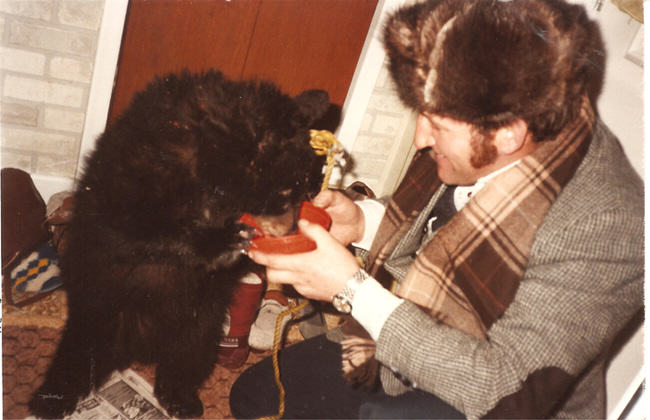
Alcide’s strength of character is also evident as he faces life’s more difficult moments: political battles in the OTA, a fire that destroys the old family farmhouse, and especially Pat’s courageous battle with cancer.
Front-Line Defenders
In recognition of Alcide’s outstanding contributions, in May 2005 he was presented with the Fur Council of Canada’s “Furrier of the Year” award, at the North American Fur & Fashion Exposition in Montreal (NAFFEM). In his speech to more than 600 fur manufacturers, designers, retailers and government officials, Alcide reminded them that trappers did more than provide the beautiful furs on display in the hall. They were also front-line defenders of the industry, using responsible practices and educating the urban population – including furriers – about the importance of using nature's gifts sustainably.
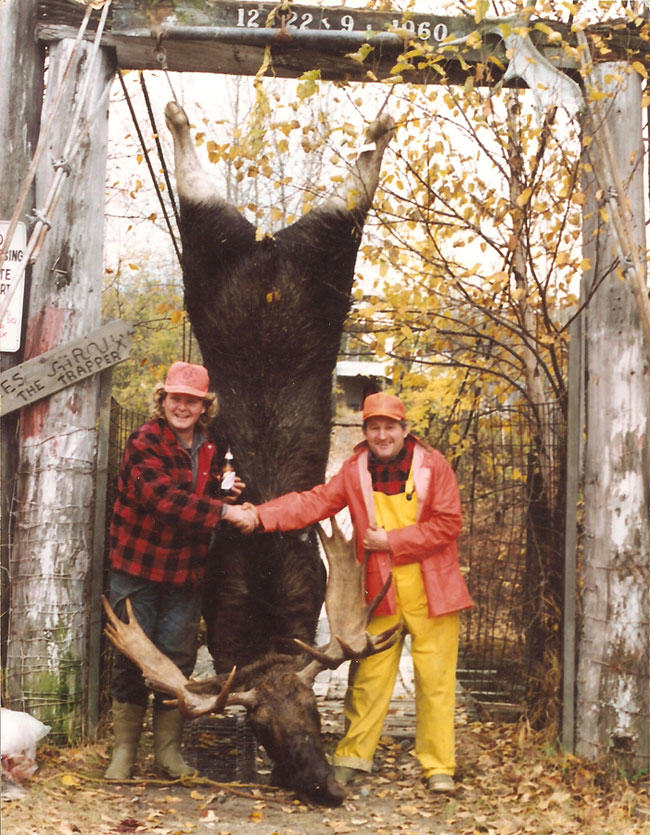
Speaking of nature’s gifts, for the gala fashion show that evening we had arranged for Alcide and Pat to sit with another celebrity: Miss Universe Canada, the beautiful Natalie Glebova. “Since trapping is always on my mind, I looked at Natalie and thought she would be good in the snow with legs like that!” Alcide remembers, with a chuckle.
The setting for most of this book, however, is in the bush, and anyone who enjoys the outdoors will appreciate Alcide’s keen observations about nature and wildlife.
To order your copy of My First Sixty Years Enjoying Nature as a Trapper, by Alcide P. Giroux (AKA “Ti-Lou”), email or call Angela Gurley of the Fur Council of Canada at [email protected] or on 1-800-376-9996. If ordering by email, please include your phone number so Angela can call for your credit card information. A French version is available, please specify whether you would like the book in English or in French. The price is $20CAD plus mailing and handling, about $6.50 in Canada and $12.50 for the US. Contact us for international shipping rates.
Le livre d’Alcide Giroux est aussi disponible en français.
SEE ALSO: NEAL JOTHAM: A LIFE DEDICATED TO HUMANE TRAPPING
(Editor's note: Alcide Giroux passed away on February 20, 2018. Read his obituary from the Fur Institute of Canada.)
An Eye-Opening Fur Workshop with Gordy Klassen and Friends
by Derek Martel, Communications Director, Fur Institute of CanadaAs the communications coordinator for the Fur Institute of Canada I sometimes spend more time in the office than I…
Read More
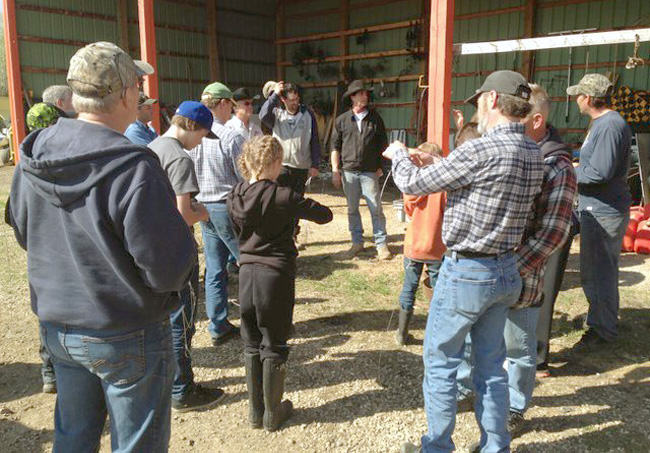
As the communications coordinator for the Fur Institute of Canada I sometimes spend more time in the office than I do out on the land with the wonderful people I work for. So when I do get a chance to get out there, I make sure to really appreciate and absorb the experience. Being offered the opportunity to go to the rural Alberta homestead of renowned trapper and wildlife advocate Gordy Klassen is just about as good as it gets.
The man they call “Trapper Gord” is well known in our industry. And yet I’d only been lucky enough to meet him face to face once, during the Fur Institute's 2015 annual meeting in Saskatoon.
I came into the fur industry as an outsider, but with an open mind. What I’ve learned is that the industry is driven by incredible people doing incredible work and providing an incredible service to wildlife conservation and sustainable resource use in Canada. The fur industry is essentially why Canada came into being, and remains a critical part of the economic, cultural and environmental tapestry going forward.
As I boarded the plane bound for Alberta on March 15, I found I was excited to go to Gordy’s ranch and see more of his and the Fur Institute’s work up close.
The visit to Gordy’s was the second half of a weeklong event hosted by the Fur Institute with a Russian delegation of four representing the fur industry and environment sector of the Russian Federation. The Russians made the trip to Canada in order to better understand the Agreement on International Humane Trapping Standards (AIHTS). It seems like the interest to further improve their hunting and trapping standards is a top priority for the Russians and they came to Canada to learn from the leading experts in the field. This week was made possible by the sponsorship of the International Fur Federation.
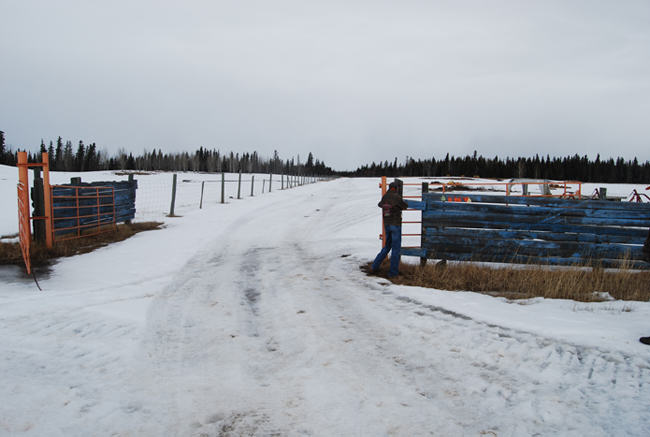
As I piled into the car bound for Gordy’s and slowly left the urban sprawl of Edmonton behind, the thing that struck me most was the feeling of being in a truly rural setting. Gordy lives in Debolt, near Grande Prairie. His ranch is just off the highway, shrouded in woods near a place that you could easily miss if you blinked.
The natural setting of being in western Canada where everything is bigger rang true. His ranch had many buildings on it and everywhere you looked there was something different to see. This was a large place, for a man with a large personality who has been a lifelong advocate for trappers and the Canadian fur trade.
Gordy welcomed us and the Russian delegation and, wasting very little time, we were soon in his legendary workshop discussing issues around trapping and, particularly, wolves.
As we got out of the car was the flat land then nothing but trees. It was as if Gordy just built his homestead in the middle of nowhere for the sole purpose of being completely enveloped in nature. It truly felt like we were at the homestead of a trapper.
The first thing we did was get welcomed by Gordy, his two young students and his many dogs. The students were like Gordy’s understudies, teenagers who participate in the Trapper Gord Wilderness College, and were completely unafraid of anything. They handled themselves like you’d expect any veteran outdoorsman to carry himself, they knew their stuff, and at times they performed like Gordy’s second set of hands.
We were ushered into his converted barn which was where we’d spend most of the next two days. This was Gordy’s chance to do what he does best: discussing trapping and the research done by the Fur Institute. Gordy’s homestead was chosen because he is a lifelong hunter and trapper and has lived it his whole life. He was able to trap and when we got there he had dispatched wolves on hand which he normally traps for clients and sells oftentimes to taxidermists.
Gordy’s expertise in trapping and wildlife management made him a great source of information, along with researchers like veterinary pathologist Dr. Rudi Mueller, Pierre Canac-Marquis (a retired Quebec Government wildlife biologist and trapper, as well as coordinator of the Fur Institute's trap research), and the rest of the Institute's Trap Research and Development Committee. They began discussing the work they do with the Russian delegation, talking about the various traps, and how best to use them and set them.
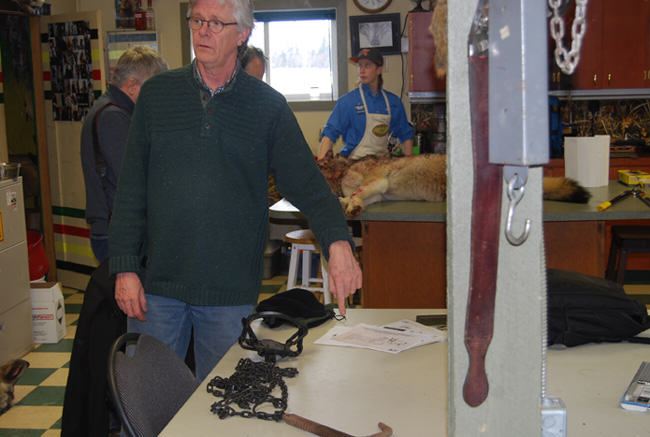
Dr. Mueller allowed everyone access to his vast expertise by way of a necropsy on a wolf. He was demonstrating specifically the workings of the trap on the animal and the cause of death. This process is obviously key in helping better understand the workings of traps and to understand the animal itself; this allows researchers to continuously improve the methods used to humanely trap and hunt these large predators.
Coming from somebody who has never really experienced this type of thing before, the opportunity was incredible. The experience was a first of many for me; I experienced some of the key parts of the fur industry. I was able to view the skinning and necropsy work being done on a wolf, showing me that it isn’t as scary as some want you to believe. The process is not bloody and the craftsmanship it takes is incredible. The care and time trappers like Gordy take to do it right is impressive and reaffirms my belief that trappers care for the animal more than anyone. This is a way of life and, for a lot of them, their livelihood, so they have far more at stake than anyone attached to these animals.
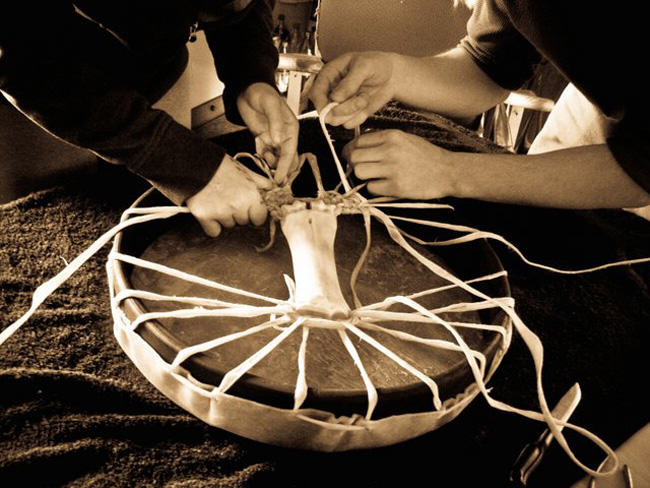
Understanding what a trapper does, through Gordy’s point of view, was an extremely worthwhile and impactful learning experience.
All in all, the trip was an opportunity to personally experience what it is I advocate for on a daily basis here at the Fur Institute. I can honestly say it has further solidified my belief in this industry and makes me want to get these great stories across to more people.
SEE ALSO: NEAL JOTHAM: A LIFE DEDICATED TO HUMANE TRAPPING
The work and care that go into it is impressive and it is clear the people in this industry care far more about the animals than any anti-use group or city dweller. They do it with respect for the environment, the animals and for the rural lifestyle they live.
It’s no wonder they are so passionate about it, and based on the few days I spent in Alberta, I can assure you it’s a passion that catches on to those who experience it.
***
RECOMMENDED READ: Trapper Gordy Klassen practises his own "brand of activism" building awareness about Canada's oldest economic endeavor. By Jodie Sinnema, Edmonton Journal, Dec. 26, 2014.
